Sept 2012
Sept 2012 sadminA journey of discovery for tourists
A journey of discovery for tourists sadminHeritage and tourism
A journey of discovery for tourists
SA Tourism
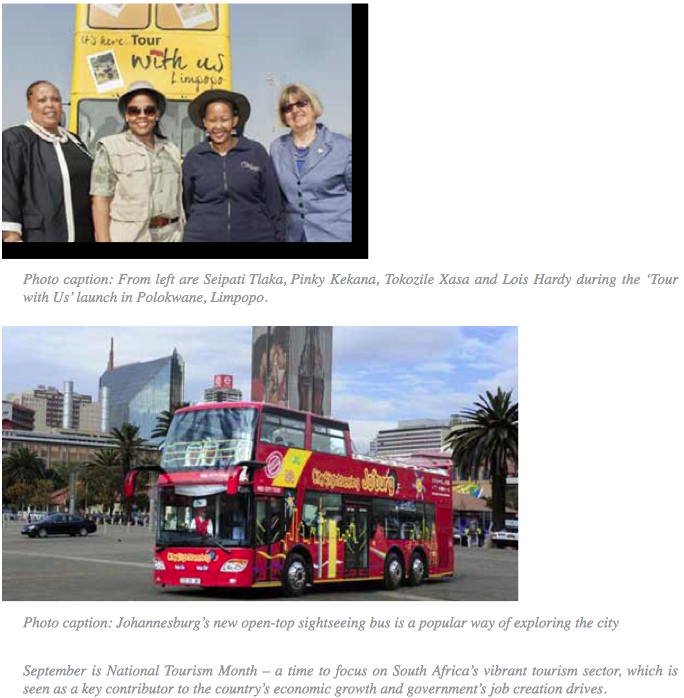
South Africa is one of the world’s top lei- sure destinations. With its rich cultural diversity and picture perfect scenery, our country offers every traveller an exciting journey of discovery.
“Going forward we would like to contribute half a trillion into the South African economy and to create an extra 225 000 jobs,” said Kingsley Makhubela Director-General at the Department of Tourism. He said these targets were set in the recently launched National Tourism Sector Strategy (NTSS), which aimed to position South Africa as one of the top 20 tourism destinations globally by 2020.
It’s here with us!
In the spirit of September being Tourism Month, Limpopo Tourism is pulling out all the stops to attract visitors to the province.
The aim of the Limpopo Tourism Agency’s marketing campaign, ‘It’s Here With Us Limpopo’ is to instil a culture of travel in the inhabitants of Limpopo and thereby grow domestic tourism.
This is in response to South African Tourism’s domestic tourism campaign, ‘Whatever You Are Looking For, It’s Here’.
Kicking off in Polokwane last month, the campaign is made up of three key elements. ‘Tour with Us’, encourages Limpopo residents, as well as all South Africans and visitors from neighbouring countries to experience the province.
‘Celebrate with Us’ invites the people of Limpopo to celebrate various provincial events such as the Marula Festival and the Mapungubwe Arts and Culture Festival.
‘Play with Us’ calls on people to support provincial sports activities to grow sports tourism. According to the Limpopo Tourism Agency executive Lulama Tshabalala, “The campaign had specifically been designed as a way to grow domestic tourism and instil a love of travel among Limpopo’s inhabitants.
From classroom to bush
During August the Limpopo Tourism Agency (LTA) hosted the Limpopo Wildlife Resorts Women’s Expedition in keeping with Women’s Month. The theme was ‘From Classroom to Bush’. Ten tourism teachers from schools in and around Limpopo were invited to tour the province with Deputy Minister of Tourism Tokozile Xasa.
“The idea is to enable tourism teachers in Limpopo to experience the varied products and adventures Limpopo has to offer. Nothing beats first-hand knowledge when you’re a tourism educator”, Tshabalala said.
The launch of the women’s expedition coincided with the roll-out of the domestic tourism campaign and Polokwane’s hop-on-hop-off bus ‘Tour with Us’. The bus will operate two routes through Polokwane, the capital city of Limpopo, from Monday to Friday, stopping at various places of interest in the city.
LTA acting CEO, Seipati Tlaka, said the domestic tourism campaign would be rolled out over three years so that the campaign’s return on investment could be measured. As a next step the LTA is taking school kids on tours throughout the province.
Deputy Minister Xasa joined tourist stakeholders on an inaugural bus tour of the city. Polokwane residents, from schoolchildren to the elderly, were also given the opportunity to hop on and off the bus and explore the city’s attractions for free.
Women in tourism
Reflecting on the role of women in tourism, Xasa said, ”The tourism sector provides various entry points for women’s employment and opportunities for creating self-employment in small and medium-sized income-generating activities. We therefore need to equip them with the necessary knowledge and skills so that the industry may continue to flourish and produce more entrepreneurs.”
A lifeline for unemployed Gauteng youth
A lifeline for unemployed Gauteng youth sadminEmployment news
A lifeline for unemployed Gauteng youth
Writer
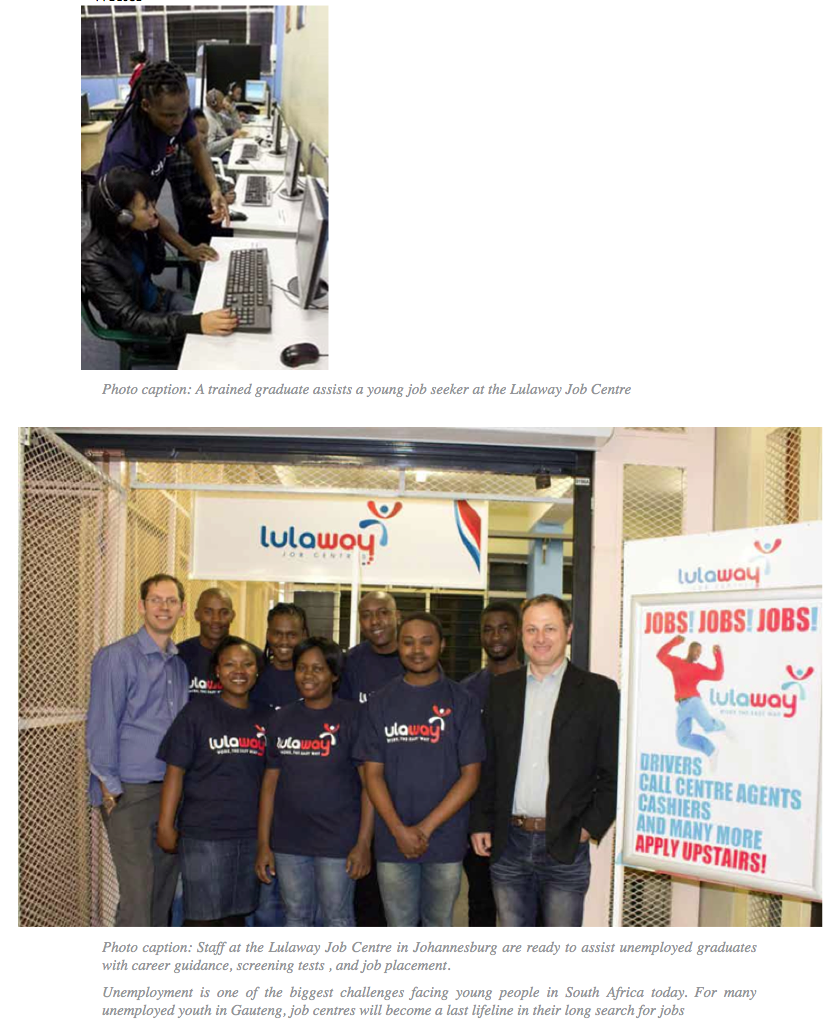
To address unemployment and poverty among Gauteng’s youth, the provincial Department of Social Development launched the first of 20 job centres recently.
The Lulaway Job Centre in Johannesburg is a walk-in facility equipped with computers and manned by trained graduates.
An estimated 8 000 young job seekers are expected to be registered and trained by the end of this 2012/13 financial year. Of these, 5 000 will be placed in various permanent positions in the private sector. More than 107 private sector companies have already pledged their support for the project.
Once job seekers register on the job portal they will receive the following benefits:
• career guidance
• screening tests
• assistance with job placement and job counselling.
Free assessments
In addition, free assessments are offered to ensure that applicants pursue careers that complement their talents and strengths.
The department’s spokesperson Sello Mokoena explained that one of the unique features of the job centre model was to ensure that entry-level positions were only available to unemployed applicants.
“We intend establishing 20 job centres throughout the province,” he said, adding that some of the areas that would benefit from the project are Thembisa, Khutsong, Kagiso, Kwa-sokhulumi, Devon, Mamelodi, Diepsloot and Sicelo (Midvaal).
“The centres will be housed in existing development and community facilities, Thusong Centres and Business Enterprise Centres as they are closer to communities,” he said.
The job centres should be seen as a part of the Gauteng Provincial Government’s greater strategy for ensuring that young people survive global economic challenges. Mokoena said that although government services were available to the youth, many still found themselves locked into poverty and unemployment because of ignorance and lack of information. They are therefore urged to make use of such opportunities as it will empower them and enable them to make informed decisions about their future careers.
For more information, call Lulaway Job Centre Call Centre: 087350 7702 or 011 243 9119 Enquiries: info@lulaway.co.za Gauteng Department of Social Development: 011 355 7600/1
Access to justice for Ashton
Access to justice for Ashton sadminSafety and security
Access to justice for Ashton
Mokgethwa Ngoepe
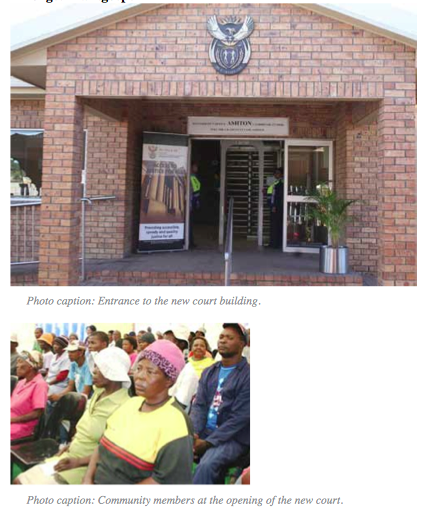
The residents of Ashton in the Western Cape have finally realised their dream of having a court in close proximity. The Minister of Justice and Constitutional Development Jeff Radebe, opened the very first magistrate’s court in the town valued at R7,6 million recently. This forms part of the department’s mandate of ensuring access to justice for all.
The majority of Ashton residents are poor and those who are employed work on farms or nearby factories. Before the new court was built, they had to travel about 50 kilometres at a cost of R60 to the nearest court.
Ashton has a population of about 26 000 and the challenges they face include substance abuse, domestic violence, rape, evictions and lack of services such as maintenance. The new Magistrate’s Court will bring family court, maintenance, domestic violence and the master’s services to their doorstep.
An excited Ashton resident, Josephine Mthinyane said the court was long overdue. “We have been waiting for this court to open, as we travel a long distance to apply for maintenance or attend court cases. Today, I would like to thank the Minister for the effort he took in making this court available for us.”
For more information, call the Department of Justice and Constitutional Development: 012 315 1111
All systems go for Afcon 2013
All systems go for Afcon 2013 sadminSport
All systems go for Afcon 2013
SAnews.gov.za

Government has reaffirmed its commitment to the hosting of the 2013 Africa Cup of Nations (Afcon) by finalising all its guarantees relating to the hosting of the tournament next year. Guarantees cover issues such as safety and security, healthcare services, transport and telecommunications. They are required so that the Confederation of African Football (CAF)
- as well as the African football community
- can be assured of a successful tournament.
Planning for the tournament, which will take place from 19 January to 12 February, has started in earnest with government pledging its support for the local organising committee (LOC) and the inter-ministerial committee (IMC) for the event. The LOC Board and the IMC are tasked with providing oversight, strategic support, planning and implementation of government’s guarantees.
Commitment
Addressing reporters at a media briefing in Pretoria recently, Sports and Recreation Director-General Alec Moemi said all relevant government departments would have to sign on their deliverables as agreed between CAF and the South African Football Association (Safa).
A signing ceremony will be held before the Afcon final draw on 26 October. Moemie said this would be a demonstration of government’s commitment to make a success of the tournament.
The LOC Board comprises 23 Safa members, seven ministers who are members of the IMC and seven representatives from business and civil society.
Departments represented in the IMC and involved in preparations for the tournament include Sports and Recreation, Home Affairs, Defence and Military Veterans, Cooperative Governance and Traditional Affairs, Finance, International Relations and Cooperation, Trade and Industry, Transport, Tourism, Public Works, Police, Health, State Security, Social Development and Communications.
Moemi said National Treasury had finalised a budget for the official host cities. These are Johannesburg where the opening match as well as the final will take place at the FNB Stadium in Soweto, Nelspruit in Mpumalanga, Nelson Mandela Bay in the Eastern Cape, Rustenburg in North West and Durban in KwaZulu-Natal.
For more information, call SAFA: 011 494 3522
Braille edition gets learners reading and talking
Braille edition gets learners reading and talking sadminVuk’uzenzele 50th Edition Special
Braille edition gets learners reading and talking
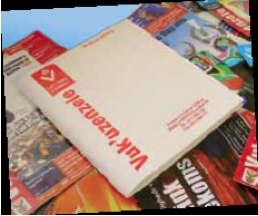
Being the only newspaper in South Africa that is published in Braille, Vuk’uzenzele offers a unique service to schools for the blind and partially sighted learners.
Vuk’uzenzele not only provides in- formation on opportunities and services to South Africans who have limited access to main-stream media, but also to those who are unable to read normal print publications.
Christiana School for the Blind in North West is one of the many schools that receive copies of the newspaper in Braille.
“Having a publication like Vuk’uzenzele has proven to be a very important means of accessing information for the school’s learners,” said Marietjie Bester principal of the school.
Blind learners are highly reliant on the Braille edition as it not only provides them with useful information, but also helps them to practice their reading skills, she added.
Learners said they enjoyed reading Vuk’uzenzele as it kept them up to date with what government offers in term of programmes and services. It also enables them to participate in discussions about these and other topical issues covered in the newspaper.
“The publication helps our students tremendously as it is in a format that gets them reading and talking about what they’ve read. It’s very important that they acquire knowledge about what is going on in their country,” Bester explained.
Call for bursary applications 2013 academic year
Call for bursary applications 2013 academic year sadmin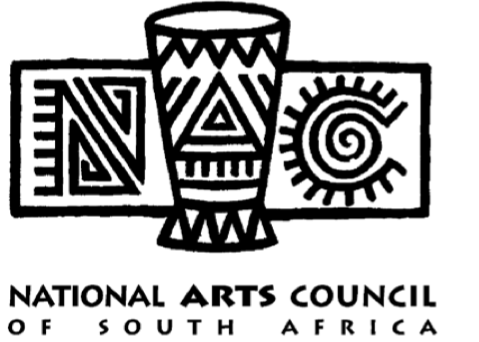
The National Arts Council invites post graduate students and registered education and training institutions that are involved in studies or provide tuition in the fi of theatre, dance, crafts, literature, music and visual arts to submit applications for bursary funding. Applications invited are for individual post graduate studies and block institution bursaries for undergraduate students who will be studying in South Africa during 2013.
• Closing date: 14 September 2012
• Outcomes available on 9 December 2012
Please note that late and incomplete applications will not be considered at all and no exceptions will be made. Application forms are available from the National Arts Council offi or can be downloaded at www.nac.org.za.
For more information, contact the Arts Development Officers at the NAC office.
PLEASE NOTE: ONLY POSTED, COURIERED AND HAND-DELIVERED APPLICATIONS WILL BE ACCEPTED.
National Arts Council, PO Box 500, Newtown, 2113
66 Margaret Mcingana Street, Market Theatre Precinct,Newtown, 2113.
Tel: 011 838 1383 Fax: 011 838 6363
Email: info@nac.org.za
Celebrating 50 editions of Vuk’uzenzele
Celebrating 50 editions of Vuk’uzenzele sadminVuk’uzenzele 50th Edition Special
Celebrating 50 editions of Vuk’uzenzele
Louise van Niekerk
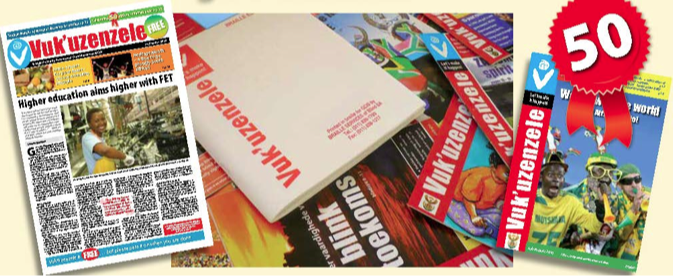
You are holding in your hands the 50th edition of Vuk’uzenzele. The first edition saw the light in October 2005, and although it has since changed its format and appearance, it continues to communicate government’s programmes and policies to all South Africans.
The first seeds for Vuk’uzenzele magazine were planted in 2004, when the need for a regular publication was identified to inform readers about economic and other opportunities created by government and how they could access such opportunities, as well as to raise awareness of government programmes in general.
Research conducted at the time, indicated that only one in three South Africans received adequate information in this regard.
Government Communications (GCIS) made it happen
With Cabinet’s approval, GCIS started with the production of Vuk’uzenzele and we haven’t looked back since.
Along with the proposal to produce a regular government publication, the name Vuk’uzenzele meaning “Wake and up and do it yourself” and its slogan “Let’s make it happen!” were also approved.
After some months of planning, followed by the launch in September 2005, the first edition appeared in October 2005. Although the magazine was aimed at all South Africans, a concerted effort was made to distribute it to those in rural areas who had limited access to mainstream media.
During the years, we featured articles on a wide variety of topics including health, education, financial planning, role models, success stories, awareness days, support for small farmers and businesses, improvements in housing and basic services and better roads and transport. We also featured news on arts, culture and sport including extensive coverage around the 2010 Soccer World Cup.
Vuk’uzenzele is also available in all the official languages although not all the pages are translated and boasts the largest print runs within the newspaper industry.
To cater for the visually impaired, it is also available in Braille, while a web version caters for those with access to the Internet.
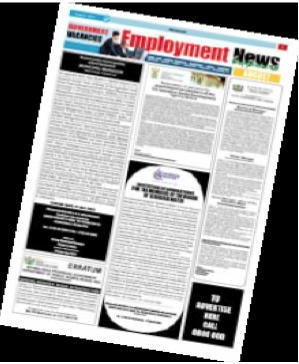
Increasing the reach
During 2010, after almost five years of existence, a review to increase the reach of the magazine without additional budget was done. Considering various options, Vuk’uzenzele magazine was changed into a monthly tabloid newspaper with the first new-look edition appearing in April 2011. The changes made it possible to print 20,4 million copies per year instead of 10 million. Now we are appearing more often and bigger than before. GCIS produces 1,7 million copies of the newspaper monthly stead of 1,6 million every second month.

Facebook and Twitter
Reflecting government’s commitment its key priority areas including its infrastructure programmes, each edition Vuk’uzenzele newspaper has dedicated ages with news about education, safety and security, health, job creation, rural development and infrastructure development.
Our special four-page Employment News supplement focuses on articles related to job creation and skills development and features advertisements for vacancies in the public sector.
The dawn of the technological era has not left Vukuzenzele behind. The paper is now available online at http://www.info.gov.za/vukuzenzele/ and maintains a healthy presence on Facebook and on Twitter.
Don’t swim against the current if drowning in debt
Don’t swim against the current if drowning in debt sadminGeneral
Don’t swim against the current if drowning in debt
Marilyn Williams - Registered debt counsellor
Are you drowning in debt? If the answer is yes, you are one of many South Africans who have been caught in the debt trap and are being harassed by debt collectors. The situation has been worsened by rising food and fuel prices and job losses.
To top this, we also live in a proud society where most people are embarrassed to admit that they are struggling to meet their monthly obligations, let alone discuss it with a total stranger.
But you don’t have to swim against the current if you’re drowning in debt. The National Credit Act makes provision for the registration of debt counsellors and debt restructuring. Consultation with a debt counsellor means that you can get immediate relief in terms of your monthly commitments while enjoying the full protection of the Act.
Sadly very few South Africans are taking advantage of this shield. Once you have received a Section 129 (required procedures before legal action), you normally have less than 20 days to seek the services of a debt counsellor. Often consumers that are over-indebted do not open or read their mail.
Ignorance is no excuse
Many feel that this is just a constant reminder of how depressing their situation is. Unfortunately, this also means that they do not know about the legal steps the credit provider has taken to recover the outstanding debt.
Ignorance is no excuse and results in a summons being issued, judgments being taken and/or property being repossessed and auctioned off in a bid to recover outstanding debt.
When you apply for debt counselling, you complete a basic application form. The debt counsellor uses this information to determine if you are over-indebted. If your application is successful, the debt counsellor will contact all your credit providers and advise them that you have applied for debt counselling.
All credit providers are obliged to stop any intended legal action immediately and offer the debt counsellor a chance to negotiate on your behalf.
Your debt counsellor may take up to 60 working days negotiating on your behalf. However you are able to get relief in terms of reduced instalments immediately. During this negotiation period it is important that you continue to pay the reduced instalment as recommended by the debt counsellor.
Debt review is designed for the ordinary per- son to be able to retain their assets even in the middle of a financial crisis. Do not wait until an auction date has been set for your property. Most clients do not know that approaching a Debt Counsellor timeously can help save your home from being sold to recover debt.
Know your consumer rights
Every day hundreds of vehicles are unlawfully repossessed in South Africa. Instead of obtaining an attachment order, tracing agents are merely intimidating clients into signing a Section 127 (voluntary surrender of goods) form. If the court has not issued an attachment order yet, you may still apply for debt counsel- ling and include the vehicle finance agreement, even if it is already in arrears.
The debt counsellor can restructure all credit agreements, including incidental credit agreements. These include, but are not limited to, mortgage loans, vehicle finance, credit cards, clothing accounts, furniture accounts, personal loans, micro loans and overdraft facilities.
It is essential that you become aware of your consumer rights. In doing so, you can inform other consumers about their right to approach a debt counsellor proactively to avoid legal action.
For more information, call the National Credit Regulator: 086 0627627 For information on debt restructuring, contact the D C Clinic tel: 086 1777293 e-mail: info@dcclinic.co.za; website: www.dcclinic.co.za
Education- A brighter future with science
Education- A brighter future with science sadminA brighter future with science
Thembisa Shologu - Gauteng Provincial Government
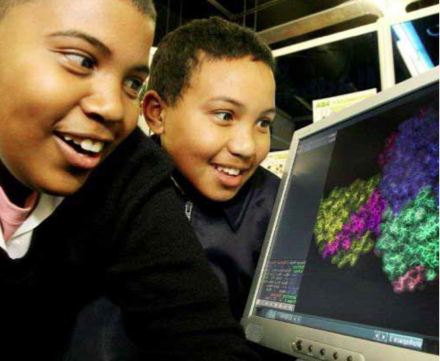
Photo caption: Learners are fascinated by an electronic exhibit during National Science Week.
South Africa has a lot to be proud of in the world of science and technology said Minister of Science and Technology, Naledi Pandor.
Speaking at the launch of National Science Week at the University of Johannesburg’s Soweto Campus recently. Minister Pandor said, “South Africans need to understand the extent to which science and technology have benefited the economy and encourage our youth to explore careers in these sectors to eventually add value to the economy.”
Under the theme “The Role of Science in Economic Development”, the event was aimed at highlighting the significance of science in our daily lives and how young people can use opportunities in this sector to ensure a brighter future for themselves and help boost the country’s growth.
Reminding the youth that all science was not necessarily ‘big science’ or ‘rocket science’’, Minister Pandor said it was sometimes simple inventions that improved people’s daily lives.
“You can turn waste into energy, you can work out how to purify water, or you can make better solar dishes or cell-phone masts,” she concluded.
National Science Week was initiated in 2000 by the Department of Science and Technology and is a countrywide celebration of science at various sites in all the provinces during one week of the year.
The celebrations are conducted in collaboration with higher education institutions, science centres, other government departments, non-governmental organisations, science councils and sponsors.
This year, activities took place at more than 89 sites throughout the country. Educational materials were distributed including science, engineering and technology career awareness information, to help learners, particularly those below Grade 12, to help them plan their future careers.
Young people were also encouraged to share their thoughts about science, technology and innovation on social networking sites such as Facebook and Twitter.
For more information, call SAASTA: 012 392 9335 or visit: www.saasta.ac.za/nsw/about.shtml, or call the Department of Science and Technology: 012 843 6300
Education- Innovative youth can change SA’s character
Education- Innovative youth can change SA’s character sadminInnovative youth can change SA’s character
SAnews.gov.za
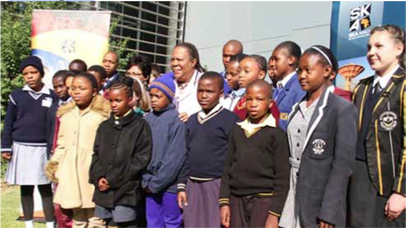
Photo caption: Minister Naledi Pandor with the winners of the SKA-Meerkat competition
Learners should be innovative so they can change the character of South Africa, said Minister of Science and Technology Naledi Pandor. The Minister encouraged learners who won the Square Kilometre Array (SKA)-MeerKat Schools Competition to study Maths and Science.
Speaking at the awards ceremony held in Pretoria recently, Minister Pandor told the winners that the country needed more scientists. “We want to invest through you,” she added.
Most exciting project
Learners in Grades 4 to 11 from various schools throughout the country were given an opportunity to enter a competition based on the SKA project. A total of 200 000 competition forms were distributed to various schools, as well as science and community centres.
The department received over 36 000 entries in the primary and high school categories.
The aim of the competition was to increase awareness of one of the most exciting engineering and research projects ever undertaken. Lap- tops, printers, digital cameras and organized tours to their nearest astronomy observatory were up for grabs.
Learners who won the competition were excited about pursuing careers that required them to study Maths and Science.
Karabo Melato, 14, a Grade 7 learner at Boitirelo Primary School, said when he completed matric he wanted to become a technician in the Defence Force. “I want to further my studies and operate big machines in the Defence Force,” he said.
A winner in Grade 8, Seth Sekhobo, 14, believes that Maths and Science will help him realise his dream of becoming a pilot. “I am interested in planes and I see myself training to become a pilot,” he said.
Exploring the galaxies
South Africa and its partner countries won the bid to host most of the telescope – 70 per cent of the telescope will be built in Africa and 30 per cent in Australia.
The core of the telescope will be constructed in the Karoo region of the Northern Cape, with outlying telescope stations throughout South Africa, Botswana, Ghana, Kenya, Madagascar, Mozambique, Mauritius, Namibia and Zambia. The magnitude and sensitivity of the SKA telescope will allow scientists to explore the origins of the first galaxies, stars and planets and the evolution of the universe. It will be able to collect weak cosmic radio signals from the edges of the universe from a time before the first stars and galaxies formed.
For more information, call the Department of Science and Technology: 012 843 6300
Education- Limpopo school keeps the flame burning
Education- Limpopo school keeps the flame burning sadminLimpopo school keeps the flame burning
Samona Murugan
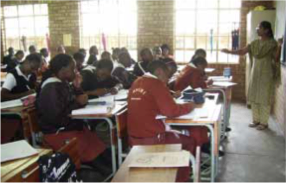
Photo caption: Despite the absence of books, teaching and learning never stopped at Mbilwi Secondary School in Limpopo
Despite being without textbooks for the first half of the year, learners, teachers and parents at Mbilwi Secondary School in Sibasa, have been determined to do well.
The school in the Thohoyandou District of Limpopo, has used creative ways to keep up with the syllabus. Living up to their reputation as Limpopo’s top school, the school rallied and reinforced why education is, and will continue to be, a key priority within this Limpopo com- munity.
“The time for excuses has stopped. We as educators could not sit back and let our children down, so we got creative,” said Principal Cedric Lidzhade.
With the help of a dedicated team of teachers and learners, the school has adopted a unique approach to education, which has resulted in several accolades and more than 100 awards.
Learning must continue
“The absence of books does not mean the absence of teaching. We as educators come to school every day and learners come to learn; we cannot simply put an end to learning because we do not have textbooks”, Lidzhade said.
“If we do not have libraries, labs and books, we must understand that these things do not unused and learners will still fail.”
When it was confirmed that the textbooks for
the new curriculum would not be delivered in time for its Grade 10 pupils, the school took a new approach. “We had old textbooks used before the Outcomes-Based Education (OBE) curriculum, so we decided to make copies of these chapters and distribute them among learners.
“In maths, factoring is factoring, whether you use the old curriculum, OBE, or the new Curriculum Assessment Policy Statement,” he said. Teachers started using the old curriculum chapters as guidelines and teaching tools to ad- minister lesson plans and tests and to prepare learners for the examinations.
It’s in our blood
In addition, the school started Saturday maths and science classes for Grade 10 upwards in January and the lessons have since been extended to all grades. The Saturday lessons see learners spending a few hours every Saturday morning learning formulas, chemistry and doing experiments.
The most fascinating and motivating outcome from all this, says Lidzhade is that, “I have not once heard any teacher complaining about the lack of books. My staff is fully equipped, hard-working, extremely dedicated and go the extra mile on a daily basis. This is what teaching is about, it is in our blood.”
Even though classrooms accommodate above average learner volumes, the school still man- ages to excel. “We have about 602 Grade 10s and the average matric class has about 70 learners. In total, we have approximately 2 300 learners at the school, which is about 1 000 more than we should admit,” he said.
“The one thing that schools must realise is that despite challenges teaching can never ever stop. There will be challenges faced, but if teachers report to school on time, and have a class full of learners, lessons must go on regardless. Teaching must start from day one,” said Lidzhade
For more information, call the Department of Basic Education: 012 357 300/ Hotline: 0800202933
Employment news
Employment news sadmin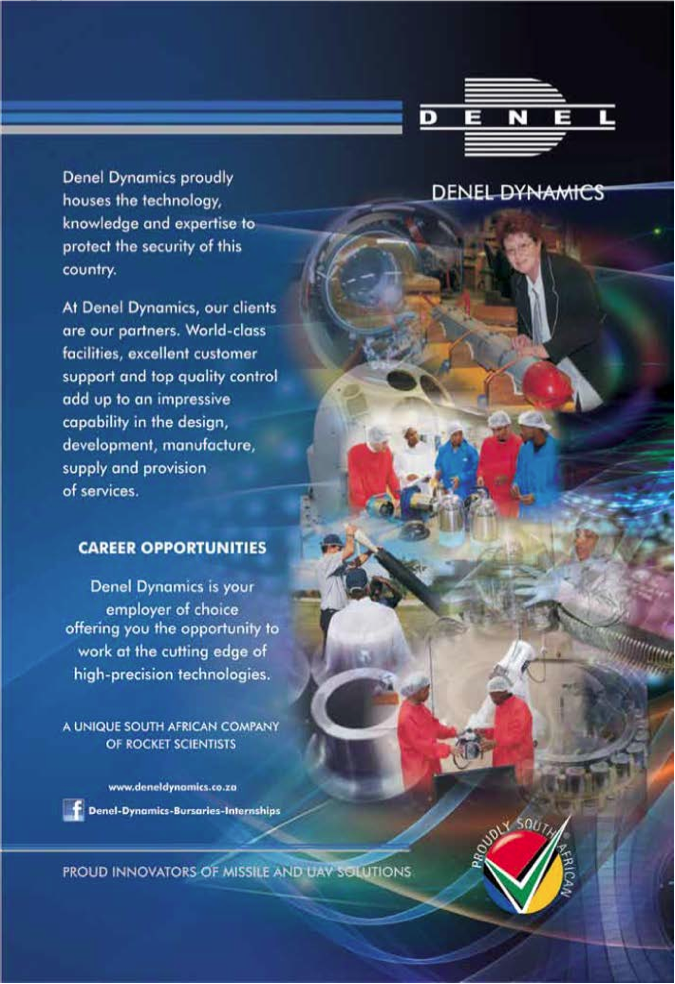
Employment news- Bon voyage for SA’s first dedicated training vessel
Employment news- Bon voyage for SA’s first dedicated training vessel sadminBon voyage for SA’s first dedicated training vessel
Samona Murugan
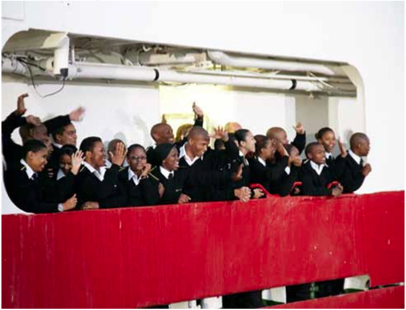
Photo caption: Trainees wave goodbye from the deck of the SA Dedicated Training Vessel.
Fifteen young maritime cadets bid a happy bon voyage as they embarked on a three-month long journey on South Africa’s first dedicated training vessel. The vessel, formerly known as the SA Agulhas, was recently re-launched in Cape Town as a training vessel to allow cadets to undergo their practical training at sea. Unveiled by the South African Maritime Safety Authority (SAMSA), the vessel is now known as the SA Dedicated Training Vessel. Apart from training, it will also be used for research and as a platform to conduct countrywide awareness campaigns.
The vessel began its official journey to London and will also visit Namibia, Angola, Ghana, Liberia and Nigeria en route to collect 30 other maritime cadets who will join those already on board.
Maritime careers
The SA Agulhas used to belong to the Department of Environmental Affairs as a polar research vessel. After almost 30 years of service, it was replaced by a new polar supply and research vessel, the SA Agulhas II.
According to Sindiswa Nhlumayo, Executive Head of the Centre for Excellence at SAMSA, the training vessel came at a time when the organisation was improving its maritime skills-development programme to increase the number of seafarers in the country. South Africa currently has less than 2 000 registered seafarers.
“We are thrilled that the vessel is finally on our books. The acquisition means a lot to SAMSA. Not only have we become the first to convert a vessel of this size to a fully-fledged training vessel in the whole world, but we’ve also helped to shape the future of hundreds of South Africans aspiring to follow maritime careers.”
The launch of the SA Dedicated Training Vessel rang in a new chapter for SAMSA that will allow South African cadets to complete their practical training on a South African registered vessel. In the past, cadets were trained on berths made available by third party shipping companies.
The vessel also strengthens SAMSA’s mandate to contribute towards the country’s maritime economic growth, Nhlumayo noted.
Future seafarers
“Skills shortage is a major challenge for the country, particularly in the maritime sector. This has contributed to a drop in active shipping companies in South Africa, but we believe that with this acquisition, we have the potential to double or even triple the size of the industry and contribute to job creation in years to come,” said Nhlumayo.
Among the future seafarers is Talent Khubela from Richards Bay, who said the training would be a life-changing experience for her.
“At first, my family was a little skeptical about me pursuing this career, but once I started I knew it was right for me. It’s everything that I was looking for in a career choice, adventure and travel.”
Another seafarer in the making, Lita Malata of Umzimkhulu, said she hoped to put her training into practice soon and looks forward to one day heading up her own fleet.
For more information, call SAMSA: 012 366 2648
Free entry to national parks for a week
Free entry to national parks for a week sadminHeritage and tourism
Free entry to national parks for a week
From 10 to 14 September, entrance to all the parks that fall under the South African National Parks (SANParks) will be free of charge. This forms part of SANParks Week, which serves to encourage people to visit national parks and to promote domestic tourism.
The parks include: the Addo Elephant National Park and Mountain Zebra National Park in the Eastern Cape; Agulhas National Park, Bontebok National Park, Garden Route (Tsitsikamma, Knysna, Wilderness) National Park, West Coast National Park, Tankwa Karoo National Park, and Karoo National Park in the Western Cape; Augra- bies Falls National Park, Camdeboo National Park, Kgalagadi Transfrontier Park, |Ai-|Ais/Richtersveld Transfrontier Park and Mokala National Park in the Northern Cape; the Kruger National Park in Mpumalanga; Golden Gate Highlands National Park in the Free State; and the Mapungubwe and Marakele National Parks in Limpopo.
For more information and reservations, call 012 428 9111or 082 233 9111.
Have a heart for your HEART – choose a healthy lifestyle
Have a heart for your HEART – choose a healthy lifestyle sadminSeptember is National Heart Aware- ness Month. It serves as a reminder that heart disease can affect anyone and that heart attacks and strokes are major killers in all parts of the world. However, in many cases they can be prevented if we change unhealthy lifestyle choices to healthy ones.
Heart disease and stroke are the number one killers in South Africa. One in three men and one in four women will suffer from cardiovascular disease (affecting the heart and the rest of the blood vessels) before they are 60 years old.
It is reported that nearly two-thirds of people who have a heart attack die before they can reach medical care. Even when stroke patients have access to modern, advanced treatment, 60 per cent die or are left disabled.
Most people think they would know if they were having a heart attack or a stroke, but that’s not always the case. Sometimes the signs are not obvious or they are similar to those of other conditions.
Heart attacks and strokes are generally caused by a blockage that prevents blood from flowing to the heart or the brain. The most common reason for this is a build-up of fatty deposits on the inner walls of the blood vessels that supply the heart or the brain. This makes the blood vessels narrower and less flexible. It is sometimes called hardening of the arteries or atherosclerosis.
The blood vessels are then more likely to get blocked by blood clots. When that happens, the blood vessels cannot supply blood to the heart and brain, which become damaged.
Research shows that a number of unhealthy lifestyle choices make the chances of suffering a heart attack or stroke more likely. These are called risk factors.
The three most important lifestyle habits that put you at risk are:
• smoking and other tobacco use
• unhealthy diet
• lack of physical activity.
These three lifestyle choices can lead to three serious physical problems:
• high blood pressure (hypertension)
• high blood sugar (diabetes)
• high blood fats (hyperlipidaemia). These are the most important risk factors for heart attacks and strokes. As these risk factors are “silent”, which means they happen in your body without any signs or symptoms, you need to have regular blood pressure, blood sugar and cholesterol level tests.
To ensure your good health, make healthy lifestyle choices – eat healthy food, lose weight if you are overweight, exercise for 30 minutes every day for five days a week, and cut out tobacco products.
For more information, call the Department of Health on: 012 395 8086/8080, or visit www.doh.gov.za
Health- Soweto mom’s HIV heroism moves Sir Elton John and US VIPs
Health- Soweto mom’s HIV heroism moves Sir Elton John and US VIPs sadminSoweto mom’s HIV heroism moves Sir Elton John and US VIPs
SAnews.gov.za
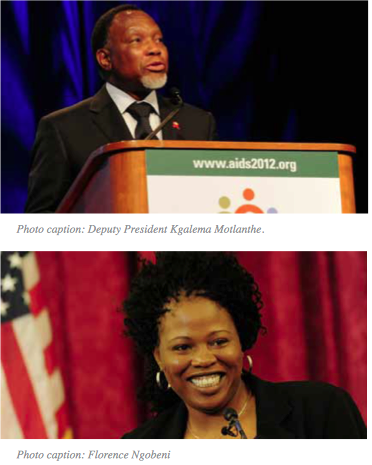
“I play before capacity crowds and get an awful sense of fulfillment from that. But the emotion cannot compare to listening to Florence this morning.”
So said Sir Elton John at a Congressional Global Aids breakfast meeting he hosted in the Kennedy Caucus Room in partnership with UNAIDS recently. The breakfast was part of the many events taking place alongside the 19th International Aids Conference.
Florence Ngobeni, an HIV-positive mother from Soweto, shared the stage with Deputy President Kgalema Motlanthe, Sir Elton John, US Senators, Congressmen and Congresswomen. She told her personal story of HIV and Aids.
Fighting spirit
“I discovered that I was HIV-positive after the birth of my fi child, Nomthunzi, who died when she was only fi months old. At that time, HIV treatment was non-existent for children in South Africa, and barely even available for adults.”
She was devastated by the loss of her baby. A little while later, she lost her partner too. She had to make a decision whether she was going to fight or give up. She decided to fight. Her fight back involved disclosing her HIV status - something that was not easy given the stigma then associated with HIV and Aids - and counsel- ling pregnant women living with HIV.
In addition to being a counsellor she spoke out on issues related to HIV and Aids, especially access to treatment.
Thank you
Florence is full of praise for the President’s Emergency Plan for Aids Relief (Pepfar), initiated by former US President George Bush, and the American leadership in general which brought wider avail- ability of antiretroviral treatment and programmes to prevent mother-to-child transmission of HIV. “I am alive today because of Pepfar. Thank you to the American people for their generosity.”
She thanked Deputy President Kgalema Motlanthe and the government for taking unambiguous steps to address the epidemic in South Africa and for enhancing coordination in the fi against HIV and Aids.
Tears of joy
Today, Florence is married and has two children, both of whom are HIV-negative. She is a strong advocate of providing antiretroviral therapy to pregnant women living with HIV to prevent the transmission of HIV to infants.
With tears [of joy, she said] streaming down her cheeks and an esteemed audience of congressmen, congresswomen, senators and former presidents of Botswana and Mozambique Quett Masire and Joachim Chissano captivated by her courage and eloquence, Florence went back to her seat - but not without a sustained applause and a standing ovation.
As Sir Elton John said, the emotion after Florence’s poignant talk could not compare.
Heritage Month a time to be proudly South African
Heritage Month a time to be proudly South African sadminHeritage and tourism
Heritage Month a time to be proudly South African
Ongezwa Manyathi
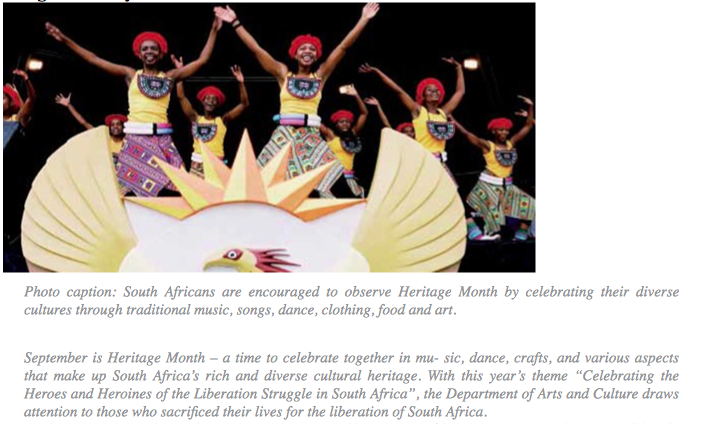
Heritage Month is a time to let your mu- sic stereo belt out South African tunes, dress up in your traditional outfit, eat South African cuisine, visit an art gallery or museum, reach out to people from other cultures and spare a thought for our struggle heroes, said Minister of Arts and Culture Paul Mashatile.
“It’s a time to bring South Africans of all races together to celebrate their diverse cultures. Even though the culture is diverse, we are also trying to create a common identity; a common South Africaness.” the Minister said.
In its quest to preserve South Africa’s heritage, the Department of Arts and Culture has started to document the story of the lives of struggle heroes and heroines through what is known as the National Liberation Heritage Route. This is a series of museums, memorial sites and monuments that honour the men and women who fought for the liberation of the country.
Earlier this year, some 28 heritage projects were announced by the department that will boost economic development in rural areas and provide opportunities to small businesses in these areas.
There will also in other African countries. A monument and Interpretive Centre will be built in Matola, Mozambique which will be opened before the end of the year. The department has invested R65 million in the project creating a total of 245 contract and 15 permanent jobs.
Local sites
Locally, there is Robben Island, Lilliesleaf in Johannesburg and the Steve Biko Centre in the Eastern Cape, which has created more than 609 jobs and will be opened later this year.
The former ANC president OR Tambo’s will also be upgraded in partnership with the Independent Development Trust. It includes the building of an access road linking Bizana to Tambo’s homestead, the construction of a statue of Tambo and the refurbishment of the Garden of Remembrance and an interpretive centre in Kantolo.
There is also a legacy project in honour of the first ANC president, John Langalibalele Dube, in Inanda KwaZulu Natal. The John Langalibalele Dube Legacy Project is expected to create about 270 jobs.
Most of the graves have been declared as national heritage sites and will be upgraded. So far the graves of PAC leader Robert Sobukwe, activists Helen Joseph, Lillian Ngoyi and Charlotte Maxeke have been declared heritage sites; those of Beyers Naude and Rashima Moosa will be declared soon. The sites are set to become tourist attractions that will create jobs and boost business in their areas.
World Heritage Convention
In celebration of 40 years of the World Heritage Convention, South Africa will host a conference from 26 to 29 September. Delegates from all over the world will be looking at how heritage sites can co-exist with a need for development.
The Department of Arts and Culture will also encourage youth to get involved in art through the Public Art Programme. Budding young artists will receive art classes before being employed in towns to beautify their respective communities through different art projects. Along with the establishment of an Art Bank, the programme will create 10 000 new work opportunities over the next three years.
In addition, a National Skills Academy will be built to give young people an opportunity to train in different art fields such as dance, music, design, technical skills like stage management, sound engineering. Working with existing art schools, the academy aims to be the school of excellence.
Aside from the heritage projects, the department has partnered with Basic Education to reintroduce art in schools. A new South African Film Commission will be established to ensure that the sector is properly resourced and the country is equipped to host film festivals to showcase talent.
For more information, call the Department of Arts and Culture: 012 441 3709
Higher education aims higher with FET
Higher education aims higher with FET sadminSamona Murugan
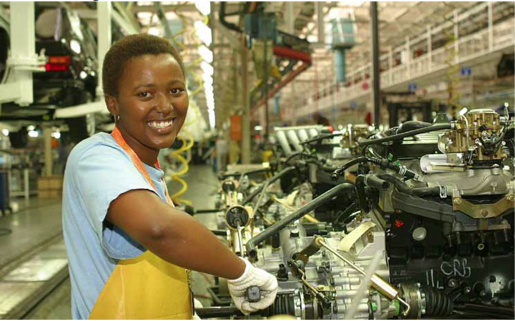
Photo caption: The FET Expansion and Development Programme Fund aims to make good quality tertiary education more accessible and affordable to even more young people. (Photo: Volkswagen South Africa MediaClubSouthAfrica.com)
“Our expectation of the FET system is that it must be a driver and catalyst for community development and tackle unemployment and poverty head on. We expect that FET colleges will reach out to communities, especially young people and offer them these opportunities.” – Minister of Higher Education and Training, Blade Nzimande.
Government is pumping more money into Further Education and Training (FET) colleges so that they can offer good quality education to even more young people.
Speaking at the launch of the FET Expansion and Capacity Development Programme Fund, Minister of Higher Education and Training, Blade Nzimande said, “Over the long term we would like to see FET colleges as a partner of choice to roll out skills development on a massive scale.”
He noted that South Africa had about three million young people between the ages of 18 and 24 who were not in employment, education or training. “A further concern is that 1,1 million young people turn 18 each year. Many of them are unable to find jobs or access formal learning and are unlikely to get into the labour market to earn a sustainable living. This is indeed a huge waste of the potential of our youth and must be tackled as a matter of urgency.”
Investment
The fund, which was started by the Department of Higher Education and Training, is one way of tackling this pressing issue head on. It is complementary and in addition to the R2,5 billion allocation announced by President Jacob Zuma in April towards the refurbishment and construction of new FET campuses over the next three years.
Minister Nzimande announced that as of 1 August, all 50 FET colleges would receive their individual allocation of the R2 billion FET Expansion and Capacity Development Programme.
He officially handed over the allocation certificates to the principals of the colleges with funding that came from the National Skills Fund (NSF) to support the expansion and growth of the FET sector, support skills development in the key growth sectors of the economy and support capacity building.
“With this investment the department and government are sending a message on the importance of FET colleges in skills development in our country. This therefore is a challenge especially to the SETAs to increase financial investment and support to these colleges, as well as to employers to move closer to the colleges, including provision of equipment, workplace opportunities for students and lecturers and staff ex- change programmes.”
Minister Nzimande said one of the ways to turn the negative perceptions about FET colleges around and turn them into institutions of choice, was to invest in improving the institutions in terms of the quality of the teaching, learning and output, as well as infrastructure and facilities.
He said the state was cracking the whip on the fly-by-night institutions and appealed to the communities to play a role in rooting them out. Despite the challenges facing his department, Minister Nzimande confirmed that his department had been working hard and continues to do so to expand opportunities for the youth, and to improve the quality of education. He said loans and bursaries to poor students from the NSFAS had been expanded substantially over the last three years. “Funds made available to students grew from R2 375 billion in 2008 to R6 billion in 2011 and are expected to continue growing.”
NSFAS funds were made available for special purposes such as R50 million for post-graduate scholarships, R63 million for students with disabilities, R350 mil- lion for poor students who were unable to register due to insufficient funding in 2012.
Figures indicate that student enrolment beneficiaries stand at a total of 102 366, which include National Certificate (Vocational) enrolments as well as other short skills programmes, learnerships and apprenticeships.
Minister Nzimande stressed that new universities and campuses were much needed.
He noted however, “The sad truth is that over the past decade we have systematically shifted state resources away from the FET system leading to its demise and ultimate decline. We have ploughed more resources into private training providers, but the economy and our socio-economic challenges have not improved.
Over the long term we would like to see FET colleges as a partner of choice to roll out skills development on a massive scale.” – Minister Blade Nzimande
Serving the people
“The 50 FET colleges and their campuses have a much larger footprint in the country than any of the other education and training systems. FET colleges therefore present us with an opportunity to not only expand access, but to also do this in a manner that serves the people of this country equitably.”
He said the new programme was a call and a unique opportunity to turn FET colleges around. “It is a historical opportunity that the youth and unemployed should grab with both hands. There is absolutely no excuse for anyone to say they do not understand what the skills priorities of our country should be, and the centrality of FET colleges in this.”
For more information about FET colleges, call the Department of Higher Education Call Centre: 0800 872222 or call: 012 312 5911
Infrastructure development -Bridge links tourists to Madiba’s legacy
Infrastructure development -Bridge links tourists to Madiba’s legacy sadminBridge links tourists to Madiba’s legacy
Nthambeleni Gabara
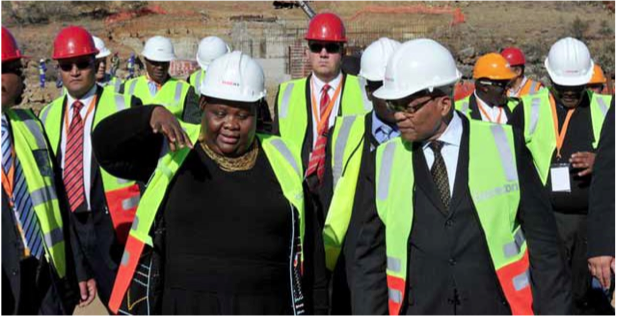
Photo caption: President Jacob Zuma with Eastern Cape Premier Noxolo Kiviet at the site of the Nelson Mandela Legacy Bridge, Ludondolo village near Mthatha
The Nelson Mandela Legacy Bridge currently under construction at former President Nelson Mandela’s birthplace, Mvezo Village in the Eastern Cape, will attract tourists to the area. So says Rural Development and Land Reform Minister Gugile Nkwinti.
Nkwinti, who accompanied President Jacob Zuma to the official launch of the bridge at Mbashe River, said the name of the bridge would be a draw card for tourists and schools as they would want to learn more about Nelson Mandela’s birthplace. The bridge will also attract more visitors to the Mvezo Museum, which displays Madiba’s legacy.
President Zuma said the bridge would substantially shorten the distance to Qunu village, where Madiba now lives.
“Many visitors, both from our own country and abroad, who wish to visit the birthplace of this world icon, will be able to do so by branching off from the national road and travelling a relatively short distance on a new road, thus turning Mvezo potentially into a major tourist attraction.”
Self esteem
Nkwinti said there would be restoration of self-esteem to both Mvezo and Ludondolo residents, as they would no longer be subjected to an embarrassing and inconveniencing situation of removing their clothes to cross the Mbashe River to access basic services such as schools and clinics.
“Stimulation of tourism in the area is likely to result in the creation of businesses in the tourism sector locally and in the province as a whole,” Nkwinti said.
Through the construction of the bridge, government priority areas such as job creation, access to education, health services and local economic development would be ad- dressed.
Taxi services are also likely to improve as the taxi industry has indicated that it would extend its services to the villages of Ludondolo and Mvezo once the tarred road and bridge were completed.
The construction of the Nelson Mandela Legacy Bridge has resulted in the improvement of job creation and skills development in the area.
Workers on the project have been trained in steel fixing, bricklaying, paving and carpentry skills that President Zuma said would make them employable in future.
“I have no doubt that the skills acquired during the bridge and road building process will enable these workers to become more employable in the future, and to access jobs elsewhere even after the completion of the project, and these workers will themselves have easier access to nearby towns,” the President said.
The Department of Rural Development and Land Reform has bought a brick-making machine that is used to manufacture bricks during the construction of the bridge.
Once the bridge and road construction projects are completed, the department will hand over the brick-making machine to the trained workers to set up a brick-making business.
For more information, call the Eastern Cape Department of Roads and Public Works: 040 609 4024 / 040 609 4008
Infrastructure development BRT system to change Tshwane landscape
Infrastructure development BRT system to change Tshwane landscape sadminBRT system to change Tshwane landscape
SAnews.gov.za
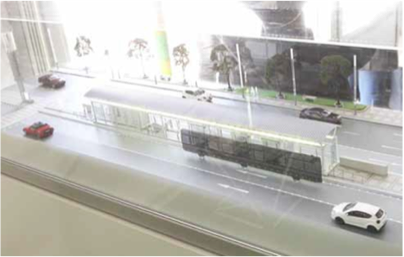
Photo caption: Tshwane’s new BRT system will go a long way towards easing traffic congestion in the city.
By April 2014, commuters in and around Tshwane will be able to hop into sleek, new buses driving in special lanes to get to their destinations without being stuck in traffic.
The Bus Rapid Transit (BRT) system is set to change the Tshwane landscape, with 51 bus stations being built in the middle of identified roads, which will all be upgraded.
Construction on the first phase, stretching from Nana Sita Street (formerly Skinner Street) in the city centre to Hatfield, was launched by Tshwane Mayor Kgosientso Ramokgopa.
The mayor said the BRT trunk route would stretch from Kopanong in Soshanguve to Mamelodi - some 80 km of road. “At peak times, trunk services will operate every three to five minutes, with feeder services every 15 minutes. The first phase of the system will be operational in April 2014, while the entire system is expected to be completed and operational by October 2015.
The system will feature dedicated bus lanes along BRT trunk routes, stations at regular intervals, and terminals at major transport interchanges to enable greater efficiency and ease of use for passengers. Some 154 buses will be procured for the system.
According to the mayor, the system will be integrated into existing public transport facilities, which will ferry passengers to and from BRT stations, improving efficiency and impact for residents.
The Hatfield station will be in the middle of Arcadia Street with dedicated bus lanes on either side of the station. Once the stations have been built and buses procured, major benefits will include rapid, reliable, safe, efficient buses with a low carbon footprint.
Building democracy
Disadvantaged areas will also reap the benefits of Tshwane’s BRT system. “We have deliberately chosen the poor areas to be serviced by the Tshwane BRT because they deserve better. We will go to Atteridgeville, Mamelodi and Soshanguve,” Mayor Ramokgopa said.
One of the major benefits of the BRT system for the city is that this landmark project will create about 11 000 jobs.
He said the BRT system was far more than just a transport project and should be viewed as one of many projects that were contributing to the building of a national democratic society, he added.
According to the city, BRT passengers can expect reduced travel times between home, work, retail and social destinations, with improvements in traffic congestion and road safety. The number of traffic accidents is likely to reduce, and those that do occur will have less of an impact on traffic flow.
For more information, call the City of Tshwane Call Centre number: 012 358 2111/012 427 2111 or the Gauteng Department of Roads and Transport: 011 355 7000
Internship programme 2012/2013
Internship programme 2012/2013 sadmin
The National Department of Health invites graduates who seek practical work experience and unemployed graduates who are interested in a public service career to apply for internship (an occupationally-based work experience opportunity) in the occupations mentioned below for a maximum of 12 months. Through this internship programme, the department aims to enhance the employability of unemployed graduates as potential employees.
STUDY AREA/QUALIFICATION AND THE NUMBER OF INTERNS TO BE PLACED
Refer to the list below for the areas interns can apply for and the relevant qualifications required.
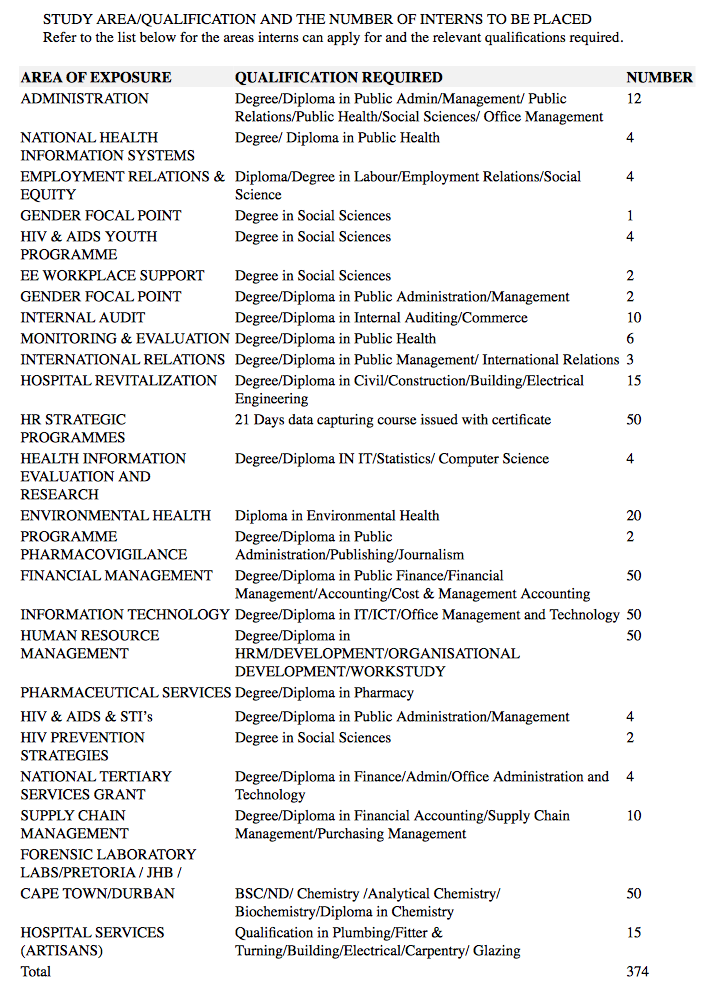
Stipend: R3 785.25/ R4 866.76 per month (depending on the level of the qualification)
Enquiries: Aubrey Masilo: 012 395 8669
Closing Date: 30 September 2012
Reference: NDOH 123/2012
Applications should be submitted on form Z83 obtainable from any public service department. It should be accompanied by a CV and certified copies of qualification certificates and a copy of your identity document. Clearly mark your application: “Internship Programme 2012/13” and the post you are applying for. Quote the above-mentioned reference number on your application for the attention of: The Director-General, Department of Health, Private Bag X828, Pretoria 0001.
Hand-delivered application forms may be placed in the “Application Box” at Reception/Security, Civitas Building, corner of Struben and Andries Street, Pretoria. No faxed or e-mailed applications will be considered. Applications received after the closing date and those that do not comply with the requirements will not be considered. The department reserves the right not to fill the posts. The successful candidate will be subjected to security and other vetting procedures. Applicants are respectfully informed that correspondence will be limited to short-listed candidates only. The Department will not be liable where applicants use incorrect or no reference numbers on their applications.
NB: All placement areas are based in Pretoria unless stated otherwise.
Investing billions to aid growth and jobs
Investing billions to aid growth and jobs sadminInvesting billions to aid growth and jobs
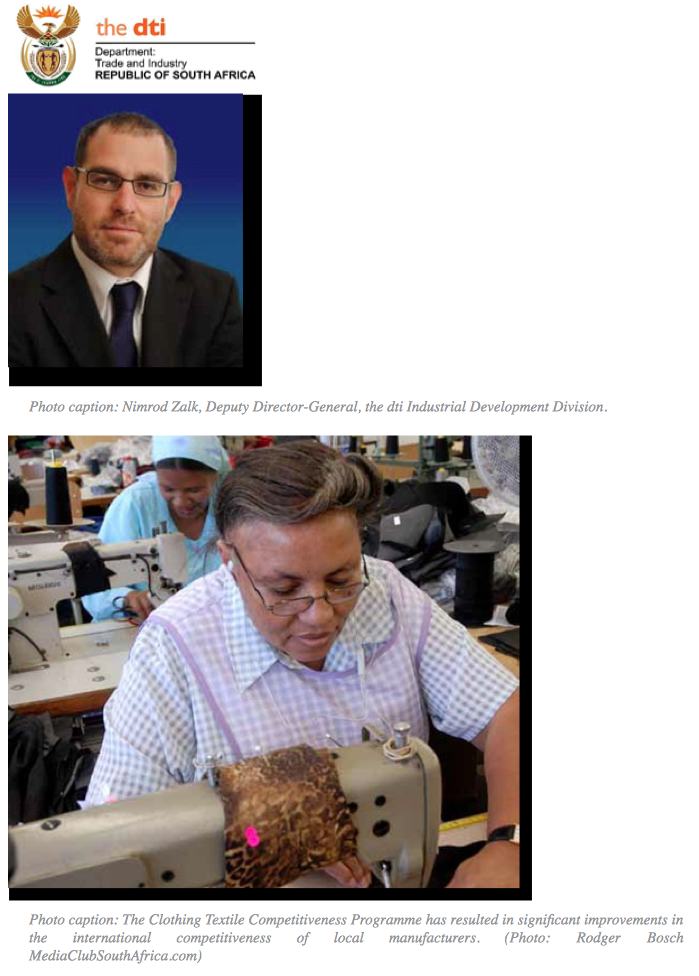
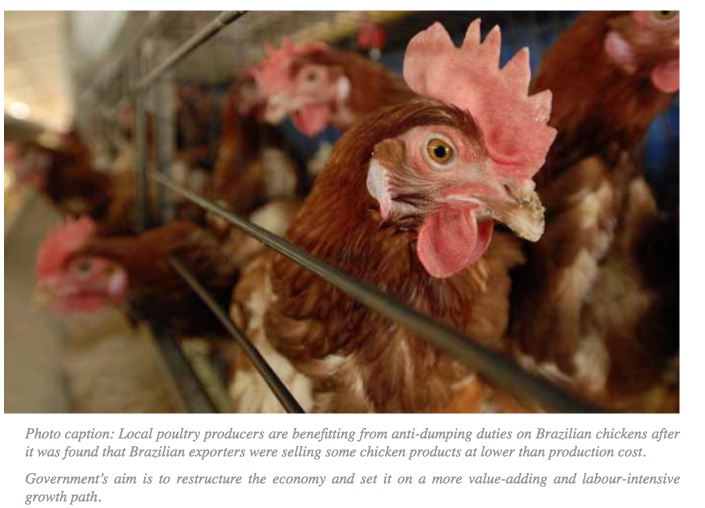
Government plans to invest billions over the next five years to support the growth and job-creating potential of a number of key sectors identified by two economic plans – the Indus- trial Policy Action Plan (IPAP) and the New Growth Path (NGP) – as it aims to reduce the economy’s reliance on traditional commodities and promote industrialisation.
IPAP seeks to create 43 000 direct and 860 000 indirect jobs in sectors that show potential for growth, including green energy, metals and machinery and agro-processing. By using a range of policy interventions, including incentives, government hopes to boost local production, exports and jobs.
Industrial policy success
The first version of IPAP launched in 2008, helped to achieve significant investments, job creation opportunities and job protection targets in a number of sectors, including automotive, clothing, textiles, leather and footwear, business process services and pharmaceuticals.
IPAP seeks to create 43 000 direct and 860 000 indirect jobs in sectors that show potential for growth, including green energy, metals, machinery and agro-processing.
“Our experience of the implementation of IPAP demonstrates that industrial policy can and does succeed in South Africa if it is well designed, adequately resourced and informed by robust and constructive stakeholder dialogue,” said Trade and Industry Minister Rob Davies.
A new policy plan for the automotive industry – South Africa’s largest manufacturing sector – has, for example, led to investment commitments of more than R15 billion from assemblers and component manufacturers. In addition, government is increasing its incentives to encourage the local manufacturing of medium and heavy commercial vehicles, with a number of investment commitments, notably a $100-million commitment by China’s First Auto Works (FAW) to invest in a joint truck and car assembly facility, already made.
In the clothing, textiles, leather and footwear sector – in which thousands of jobs have been lost over the past decade as local manufacturers struggled to compete with cheap and often subsidised imports – the Clothing Textile Competitiveness Programme has resulted in significant improvements in the international competitiveness of local manufacturers.
Major achievements
One of the major achievements of IPAP is the finalisation of changes to the regulations regarding the Preferential Procurement Policy Framework Act. This legislation governs the way government, a major buyer of goods and services, spends its money.
Designated sectors that benefit from the regulations include buses, canned vegetables, clothing, textiles, leather and footwear, rolling stock and power pylons.
South Africa has also made significant progress in making changes to fund plans set out in IPAP and NGP. It intends investing R102 billion in a variety of sectors over the next five years, including the following:
■ R25 billion in renewable energy products to help build the “green economy”;
■ R10 billion in a job creation fund at discounted interest rates to encourage investment in labour-intensive projects;
■ R500 million in an energy efficiency fund;
■ R7,7 billion for investment in agricultural and forestry value chains; and
■ R6,1 billion to support companies in dis- tress because of the global financial crisis.
A manufacturing tax incentive has led to large investments in the sector worth R21,8 billion. A research and development incentive has encouraged private sector companies to undertake activities worth R9,6 billion in the five years up to 2011.
Improving manufacturing competitiveness
The relatively new Manufacturing Competitiveness Enhancement Programme aims to improve the competitiveness of labour-intensive and value-adding manufacturing sectors affected by the currency, global crisis and the increases in electricity costs.
The departments of trade and industry, and of economic development, as well as National Treasury has also aligned trade and competition policy with industrial policy.
By addressing price-fixing and other uncompetitive market behaviour, for example, in the steel industry, input costs for other manufacturers who use steel as a key ingredient in their production processes can be significantly reduced.
Trade policy can also boost local industrialisation by protecting domestic producers from unfair international competition. Local poultry producers, for example, are benefitting from anti-dumping duties on Brazilian chickens after it was found that Brazilian exporters were selling certain chicken products in the local market at lower than their production cost.
Why do we need an industrial policy?
IPAP forms a critical part of government’s strategy to restructure the economy and set it on a more value-adding and labour-intensive growth path.
Instead of exporting commodities such as platinum, iron ore, coal and manganese and then importing the value-added manufactured products, the aim is to reduce reliance on the production and export of “raw” commodities and increase the proportion of value-added goods manufactured locally.
IPAP aims to increase the growth of the production sectors, particularly manufacturing, which can play a critical role in driving income growth and employment.
“Studies have shown that manufacturing has the highest economic growth multipliers in the economy and a number of high employment multipliers,” said Nimrod Zalk, Deputy Director-General of dti’s Industrial Development Division.
“Manufacturing uses primary products and components, which must be produced in other productive sectors of the economy and then supplied to manufacturing companies,” he added. An investor opening a tomato processing plant would, for example, would benefit a range of sectors in the value chain. Beneficiaries would include farmers and their employees, fertiliser and pesticide producers, transportation companies, steel companies that manufacture cans and design companies that produce labels.
If the tomatoes were simply exported and processed elsewhere, a number of spill-over effects would be lost for domestic economy.
Production-driven growth is seen as a more sustainable growth path from an income-and employment growth-perspective. Instead of economic growth being driven by consumption-driven sectors – such as finance and insurance, real estate, communication, wholesale and retail, catering and accommodation – the aim of IPAP and various other government plans is to tilt South Africa’s growth path towards production-driven sectors, such as agriculture, mining, manufacturing and construction.
The aim is to tilt South Africa’s growth path more towards production-driven sectors such as agriculture, mining manufacturing and construction.
Growth multipliers
Specific sectors with some of the highest growth multiplier effects include food, textiles, apparel, wood and wood products and motor vehicles, parts and accessories.
Because the automotive production sector is seen as a significant job and growth multiplier, many governments around the world create incentives to attract investment in the sector. In South Africa, the automotive production sector contributed 6,2 per cent to the GDP in 2010 and employed 103 000 people directly. A further 200 000 people are employed in the retail and repair areas. The government’s support measures through IPAP has boosted the number of vehicles produced locally by about 19 per cent and has supported at least 33 524 jobs.
Joining hands to tackle today’s challenges
Joining hands to tackle today’s challenges sadminInternational relations
Joining hands to tackle today’s challenges
SAnews.gov.za
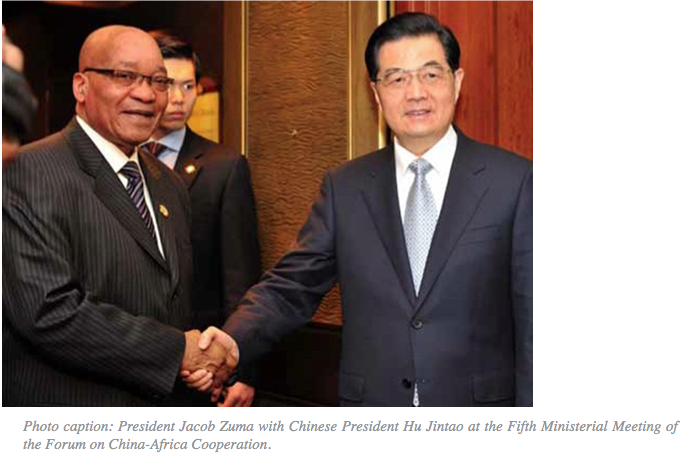
President Jacob Zuma has called on China to deepen its partnership with Africa in tackling today’s challenges. He identified infrastructure development, information and communication technologies and energy as the key areas needing attention.
Speaking at the Fifth Ministerial Meeting of the Forum on China-Africa Cooperation (FOCAC) in Beijing recently, President Zuma said China’s commitment to Africa was already being demonstrated, particularly in terms of human resource development, debt relief and investment.
He added that South Africa wanted to in- crease exports to China and welcomed more Chinese investment in its infrastructure development, industrial zone and mining industry to boost mutual trade, as well as Africa’s economic development.
Chinese President Hu Jintao proposed measures in five priority areas to boost ties between China and Africa. He said in the next three years, his government would take measures in these areas to support peace, development and investment in Africa.
The first priority area is expanded cooperation in investment and financing to support sustainable development in Africa. China will provide $20 billion of credit line to African countries to assist them in developing infrastructure, agriculture, manufacturing, and small and medium-sized enterprises.
Secondly, China will continue to increase development assistance to Africa. This will include improved agricultural technology to help African countries increase production, the training of 30 000 people in various sectors 18 000 government scholarships and building of cultural and vocational skills training facilities. In addition, China will increase medical and health cooperation, meteorological infrastructure and forest protection and management, as well as well-drilling and water supply projects to provide safe drinking water to African countries.
The third priority is Chinese support for the integration of African countries through transnational and trans-regional infrastructure development programmes.
The fourth priority is improving people-to-people friendship to support and promote exchanges and cooperation between people’s organisations, women and youth of Africa and China. This includes a proposal to set up a China-Africa Press Exchange Centre in China to encourage exchanges and visits between Chinese and African media.
Lastly, Hu said China would promote peace and stability in Africa and create a secure environment for Africa’s development.
To this end, China will launch the Initiative on China-Africa Cooperative Partnership for Peace and Security, deepen cooperation with the African Union (AU) and African countries for peace and security in Africa, provide financial support and training for the AU peace keeping missions in Africa, as well as for the development of the African Standby Force.
The Sixth Ministerial Conference of the FOCAC will be held in South Africa in 2015.
Medals of recognition for military veterans
Medals of recognition for military veterans sadminGeneral
Medals of recognition for military veterans
SAnews.gov.za
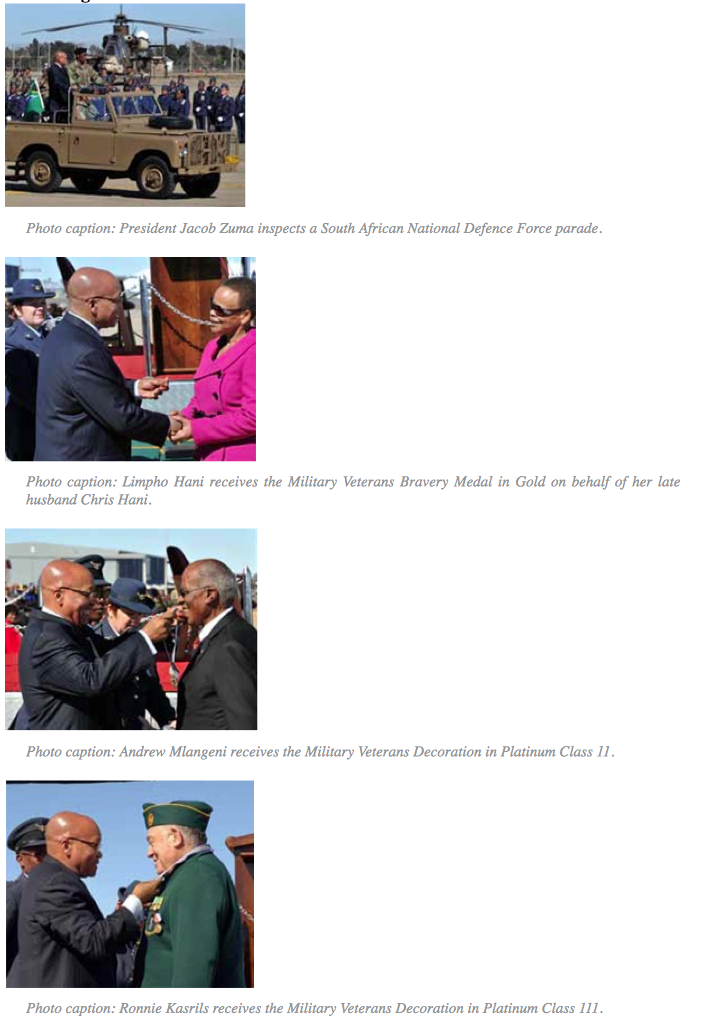
About 74 medals were awarded to former Umkhonto We Sizwe veterans in recognition of the sacrifices they made in bringing about peace, democracy and freedom. These are the people who contributed immensely and selflessly to the achievement of the country’s democracy.
President Jacob Zuma, accompanied by Minister of Defence Nosiviwe Mapisa-Nqakula, presented the medals recently at the Bloemspruit Air Force base near Bloemfontein.
Describing the military veterans as people who dedicated their lives to liberating the country regardless of what the price of democracy was, the President said, “People should not take our democracy for granted; there are people who died for it.”
The military veterans were honoured in four categories, namely Platinum I, II, III and the Gold Bravery Medal for those who showed exceptional bravery.
Among the recipients was the late Chris Hani who was represented by his wife Limpho Hani. Former President Nelson Mandela along with struggle heroes Walter Sisulu and Govan Mbeki received Platinum Class II awards. Former President Thabo Mbeki was awarded a Platinum Class I award.
President Zuma takes diplomats through SA’s vision
President Zuma takes diplomats through SA’s vision sadminInternational relations
President Zuma takes diplomats through SA’s vision
Chris Bathembu
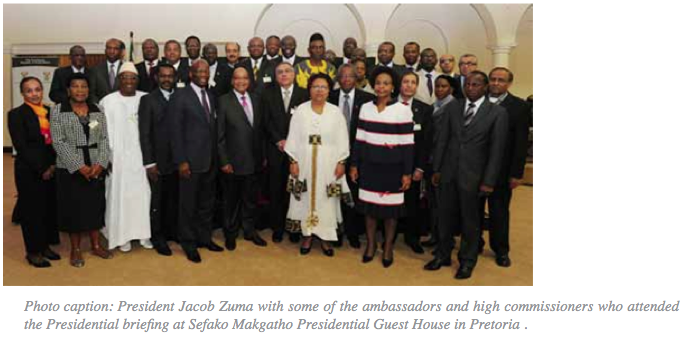
South Africa will continue to create an environment that encourages investment in the country’s economy, said President Jacob Zuma. He was reaching out diplomats assuring them that in South Africa they have a stable, reliable partner.
Addressing more than 120 ambassadors and high commissioners at the Sefako Makgatho Presidential Guest House in Pretoria, the President said government was taking steps to encourage investment in the country’s economy.
He briefed a gathering on government’s key priority areas of education, the fight against crime, creating decent work, improving healthcare, education, rural development and land reform.
Attracting investors
“Departments have been instructed to grant approvals for licences on time. They must pay suppliers on time and generally remove hassles and make it easier for investors to start their business,” said President Zuma. “We are changing regulations to make it easy for the private sector to do business.”
President Zuma noted that South Africa was investing in a massive infrastructure programme which he said would further attract investors to do business in the country.
The National Treasury had allocated more than R77 billion over the next three years to help several infrastructure programmes get off the ground.
Learning and teaching
“As we change the landscape of the country, we also intend to create more job opportunities,” Zuma said, adding that economic success depended on the country’s performance in education.
“One of our preoccupations currently is to improve the quality of learning and teaching in schools...the role of teachers is critical and we will continue to invest in producing more teachers who can teach mathematics, science and African languages.”
Government had also realised that the target of producing more than 40 000 teachers by 2014 was not sufficient to meet the future demand for teachers, particularly at foundation phase. To address this, institutions offering foundation teacher education would be increased from 13 to 21 in the next four years, he said. Turning to health, President Zuma said South Africa had managed to decrease the transmission of HIV from mother to child from 3,5 per cent to 2,7 per cent since 2010, effectively saving the lives of more than 100 000 babies. To further improve the general health infrastructure, the National Health Insurance scheme will be phased in over 15 years. It is currently being piloted in 10 districts, said the President.
Rural development- Smallholder farmers yield crops and jobs
Rural development- Smallholder farmers yield crops and jobs sadminSmallholder farmers yield crops and jobs
Nthambeleni Gabara
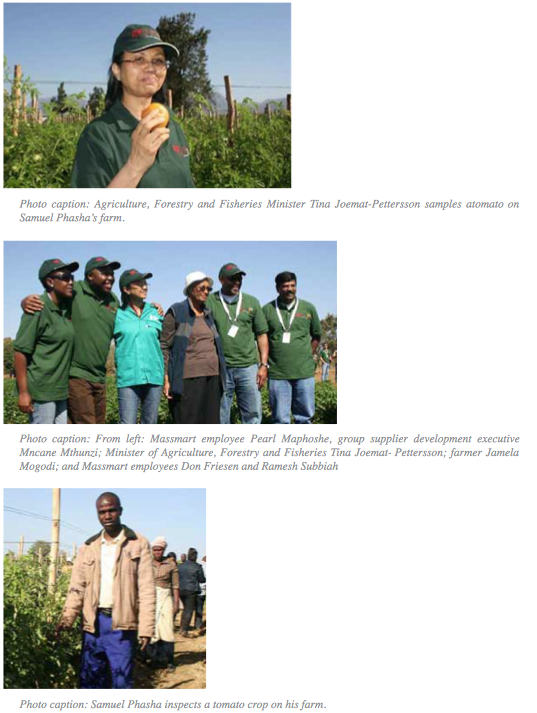
Farming in South Africa comes with many challenges for smallholder farmers who have minimal resources and skills to compete in the commercial environment.
A major challenge for Samuel Phasha, a 37-year-old farmer from Tzaneen in Limpopo, was the lack of a market where he could sell his fresh produce. He also needed a proper irrigation system and a new tractor, but couldn’t pay for it.
However, since the Ezemvelo Massmart Direct Farm Programme came to his rescue, things started looking up for him. He has since improved his farming methods and gained skills to manage his business finances.
The Ezemvelo programme, which is being piloted in Limpopo, aims to develop and support small farmers to supply Massmart with fresh produce in Tzaneen.
It is a partnership between government and the private sector designed to enable smallholder farmers, mostly in rural areas, to improve production and access markets.
Training
“This season, I will harvest a butternut crop for Massmart. It is good to have the certainty of a market and it’s good to have a buyer come to me,” said Phasha, who has created 14 jobs for local residents on his farm at Ofcolaco near Trichardtsdal, outside Tzaneen.
Apart from butternut, he will supply tomatoes, cabbage, carrots, pumpkin, sweet potato, potatoes and onions to Massmart.
Phasha, who has been farming for 11 years (not “the past” 11 years – it’s obviously not possible to farm in the future), also hopes to benefit from a three-year financial management training course as part of the Ezemvelo programme.
Access to markets
Another smallholder farmer in the area, Jamela Mogodi, 73, said the pilot project gave her more confidence to improve her production, adding that with a further year of support, she would be able to stand fully on her own.
Mogodi is currently growing green beans, butternut, tomatoes, dry beans and green peppers on 28 hectares of land. She has two tractors, including one she received from the provincial Department of Agriculture, a trailer, a plough, a dresser and a ridger.
Before joining the Ezemvelo pilot project, the retired nurse from Julesburg was selling her produce to the local market. Due to high transport costs and the cost of packaging materials, she struggled to access other markets further away.
“Through this partnership with Massmart, I will now supply various grades of vegetables to Cambridge Food and Game Foodco stores through Massmart’s fresh produce division Massfresh.”
Jobs for women
Speaking at the launch of the Ezemvelo programme, Agriculture, Forestry and Fisheries Minister Tina Joemat-Pettersson said small-holder farms were creating jobs for women in poverty stricken communities.
“What you have seen here today is a confirmation that smallholder farmers are creating jobs, even though they are not as recognised as commercial farmers. While commercial farmers were shedding jobs, smallholder farmers were creating jobs and that addresses the problem of unemployment.
“In this Ezemvelo programme, the majority of participants are women and black women in general. It is African women who are in the [grip] of poverty, they are the poorest of the poor, but through this, we are assisting them to put food on the table as well as earning an income.”
The initiative forms part of a R15 million three-year supplier development deal between Massmart and TechnoServe, a non-government organisation involved in entrepreneurship and agricultural development.
The deal is the result of a R100-million supplier development fund aimed at improving the competitiveness of South African manufacturers and producers as part of the Massmart-Walmart transaction.
The pilot project, the first of several to be rolled out across the country, is in line with Massmart’s commitment to develop local suppliers.
For more information, call the Department of Agriculture, Forestry and Fisheries: 012 319 3719
SA goes with the WaterAid flow
SA goes with the WaterAid flow sadminEmployment news
SA goes with the WaterAid flow
Yuven Gounden
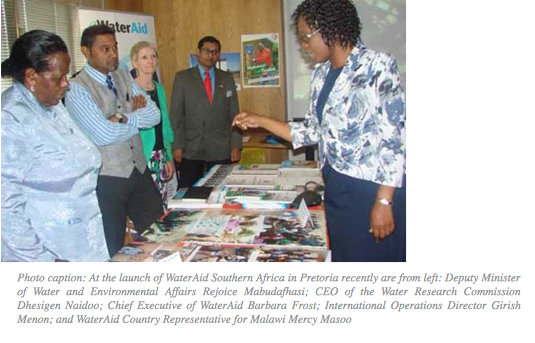
Cultural dancing, eye-catching exhibits, informative talks and good food characterised the recent launch of the Southern Africa WaterAid offices in Pretoria.
WaterAid, an international non-government organisation, is dedicated to improving access to safe water, hygiene and sanitation in the world’s poorest communities. It has been active over the past 31 years in 27 countries through four regional teams in Asia, West Africa, East Africa and Southern Africa.
WaterAid works with local partners who understand local issues and provides them with skills and support to help communities set up and manage sustainable projects that meet their needs.
WaterAid Southern Africa is hosted by the Water Research Commission (WRC) and it is housed in the WRC building.
Shared passion
Welcoming WaterAid to South Africa, Deputy Minister of Water and Environmental Affairs, Rejoice Mabudafhasi said government would partner with them to address problems relating to safe water supply and sanitation.
“We share the WaterAid approach where we consult with communities and get them to take ownership of the project before we implement. We also share their passion for capacity building, especially developing young talent,” she added.
Girish Menon, the Director of International Programmes, described South Africa as a “source of inspiration and beautiful hope. Applauding the country for being a world leader in water and sanitation” matters, he said WaterAid saw the South African government and the WRC as worthy partners in the universal goal of improving the quality of lives of poor people in the region and worldwide.
Impressive progress
Robert Kampala, Head of South Africa Region, said, “WaterAid also provides flexibility to respond to opportunities and challenges as they arise, such as opportunities for influencing new partnerships. It further provides an opportunity to work closely with the South African government, which has a stronger regional and international influence in realising the rights to water and sanitation for the poor.”
Barbara Frost, Chief Executive of WaterAid, said they were impressed by the progress made by South Africa. She noted, however, that 2,5 billion people globally still lived without access to toilets and 783 million didn’t have safe drinking water.
For more information, call the Department of Water Affairs: 012 336 8387 or visit: www.wateraid.org/
SA’s most glittering Olympic success
SA’s most glittering Olympic success sadminSport
SA’s most glittering Olympic success
SAnews.gov.za

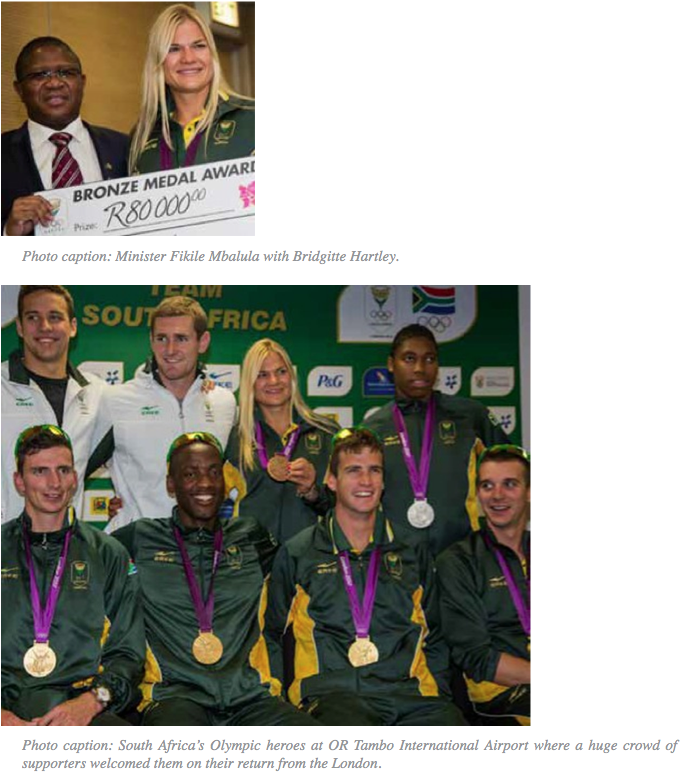
South Africa will remember 2012 as the year our Olympic team put on its best performance since the country was readmitted to the Olympic Games.
South Africa finished as the leading African nation and in 24th position on the fi medals table. Team SA’s medal tally put the country just ahead of Ethiopia, which ended in 25th position with three gold, one silver and three bronze medals.
The team brought home three gold medals – from swimming sensations Cameron van den Burgh and Chad Le Clos and the rowing team comprising of Sizwe Ndlovu, Matthew Brittain, James Thompson and John Smith.
Our silver medals came from Caster Semenya and Chad Le Clos, while Bridgitte Hartley
bagged a bronze in the women’s canoe sprint.
This year’s heroic feat closes the chapter on the 2008 Beijing Olympics when the team managed just one silver medal from long jumper Kgotso Mokoena.
Resounding success
“This Olympics has definitely been our most successful Olympics ever with the six medals we have won,” said Sport Minister Fikile Mbalula.
He said although we didn’t achieve the 12 medals target set by Sascoc, the three gold medals achieved by our athletes was a re- sounding success and “we should embrace, treasure and cherish them.”
The Minister also expressed his satisfaction with the all-round performance of the athletes, adding that the London Olympics laid the basis for the country’s march towards the 2016 Rio de Janeiro Olympics in Brazil.
Uniting the nation
Giving them a heroes’ welcome at the OR Tambo International Airport, a huge crowd blew their vuvuzelas, sang the national anthem and the well-known Shosholoza and waved the flag in true South African spirit, proving once more that sport plays a major role in uniting the nation.
Praising the medalists, Sascoc Chef de Mission, Patience Shikwambane said, “...we salute you, you’ve made us very proud.”
Echoing Shikwambane’s words, Sascoc CEO Tubby Reddy said, “These athletes really made us proud with their excellent performance and achievements.”
President of Sascoc Gideon Sam who set the target of 12 medals for Team SA, gave the Olympians a ten out of ten ranking. “I am 100 per cent satisfied with the performance and with what we’ve achieved. We set the target precisely because we wanted to work towards something. We tried our best and in the coming weeks I will give the medalists a programme in preparation of the Rio de Janeiro Olympics in 2016.”
Monetary rewards
The medalists also received money in recognition of their achievements.
Le Clos received an amount of R600 000 for winning gold and silver, while his coach Graham Hill received R150 000. Van den Burgh received R400 000 and his coach received R100 000. Rowing team members Ndlovu, Brittain, Thompson and Smith each received R100 000.
Caster Semenya, who closed Team SA’s London Olympic campaign with a silver medal in the 800m women’s race, received R200 000 and her coach Maria Mutola R50 000. Bronze medalist Hartley took home R80 000.
For more information, call Sports and Recreation South Africa: 012 304 5000
Safety and security- Ex-offender turns his life around
Safety and security- Ex-offender turns his life around sadminEx-offender turns his life around
Elfas Torerai - Department of Correctional Services
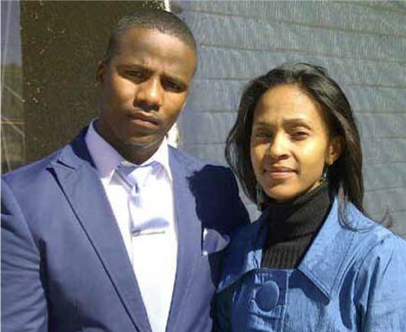
Photo caption: Pastor Brando Lottering and his wife Petronella
The story of a former alcoholic and ex-offender from Rooigrond who has turned his life around and is now a leading church pastor in Vryburg, is a prime example of how the corrections system has success - fully led to rehabilitation. His story inspired many young people from the area notorious for its rampant drug abuse.
Our focus is on the corrections system and breaking the cycle of crime,” said Minister of Correctional Services Sibusiso Ndebele recently.
Minister Ndebele, who was addressing Parliament, said, “Key to rehabilitation is empowering offenders to have skills to function effectively in society on their release. It is equally important to ensure that offenders are actively involved in productive activity while they serve their sentences…
“Our plans focus quite strongly on the improvement of offender involvement in education and skills development programmes.”
Relating his story to the community of Danville in Mafikeng during an event to mark International Day against Drug Abuse and Il- licit Trafficking, Pastor Brando Lottering urged people, particularly the youth, to shun alcohol and substance abuse.
Lottering, now in his late 30s, said he almost wrecked his life beyond redemption when he started substance abuse some years ago.
“I started substance abuse when my parents divorced, because their separation left me emotionally dead. I became an alcoholic and at times I wouldn’t fear anything and would drive recklessly. I was involved in two accidents and only survived by the grace of God,” he said. His world started falling apart completely when he turned to crime to feed his addiction.
Arrested and convicted of robbery, Lottering was sentenced to 10 years behind bars. “I was sentenced to 10 years for stealing R1 million and I was only released from prison in May this year.”
While in the correctional centre, isolated from society, Lottering decided to turn his life around. Thanks to the Department of Correctional Services’ policy of involving offenders in education and skills development, he was given an opportunity to study.
“I studied theology in prison – I’m now converted and running the Mount Carmel Church International Ministries in Vryburg”, he said. Lottering called on parents in Danville, a com- munity said to be infested with drug abuse, to raise their families together so that the drug cycle could be broken.
“In our family, I’m the only one who has escaped the drug net. What I have learnt is that parents have to bring up their children in love to avoid what some of us went through.”
A bystander at the event, who requested anonymity, said he was still on drugs like many other young people in Danville, and it was ruining his life. “We are often high on tik, khat and methamphetamine. It has become part of us and we do it often.” He hoped Lottering’s message would not fall on deaf ears.
For more information, call the Department of Correctional Services: 012 307 2000/ Anti-corruption hotline: 0800701701
Safety and security- Getting the police to march in step
Safety and security- Getting the police to march in step sadminGetting the police to march in step
Thomas Thale
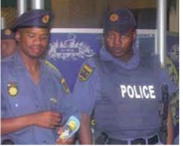
Photo caption: The new Civilian Secretariat for Police will help to ensure that police operate within the Constitution.
Policing in a democratic state requires civilians to keep an eye on the police, making them accountable to the public and to the Constitution. In South Africa, it is the responsibility of the Civilian Secretariat for Police to monitor the South African Police Service (SAPS), ensuring that they march in line with the needs of the public and operate within the Constitution.
Where gaps exist, the secretariat, through its head, Jenni Irish Qhobosheane, advises the Minister on policy development to keep the police responsive to public needs and government priorities.
Pinda Ntsaluba, Director of Communications at the secretariat says one of the key functions of the secretariat is “to ensure public participation and involvement in the fight against crime”.
Community cooperation
To strengthen the relationship of the SAPS to the community, the secretariat supports Community Policing Forums (CPFs).
Dumezweni Zimu, SAPS’ Chief Director of Partnerships, says the secretariat “helps communities in establishing, training and empowering CPFs through various capacity programmes. We also assist the CPFs to influence policing on the ground.”
Zimu adds that the Secretariat also co- ordinates various activities on common issues that affect communities within each police precinct and facilitates alignment across provinces on issues relating to CPF between police and CPFs, we intervene.”
The Civilian Secretariat for Police was set up in terms section 208 of the Constitution. This empowers the body to monitor the performance of and systems used by the police and to recommend actions to be taken by the Minister to correct weaknesses in the police.
One of the secretariat’s key responsibilities is to ensure that police comply with the provisions of the Domestic Violence Act.
According to the Act, victims of domestic violence must be treated with sensitivity and care and reasonable steps must be taken to protect complainants from any further danger.
The secretariat also looks at how the SAPS uses its budget to ensure that it complies with the law.
Your democratic right
But the Civilian Secretariat should not be confused with the Independent Police Investigative Directorate (IPID).
While the secretariat has the power to obtain any information from the SAPS and to guide police on corrective steps to take, the IPID deals specifically with the conduct of SAPS members and investigates issues around deaths in police custody and other human rights abuses.
Every South African has the right to make proposals about policing or to report serious matters that need the attention of the Ministry of Police. So, exercise your democratic right and help make the police accountable.
For more information or to make a proposal, call the secretariat on 012 393 2500 or 012 393 2536 Website: www.policesecretariat.gov.za
Switch off and save; it’s the right thing to do
Switch off and save; it’s the right thing to do sadminGeneral
Switch off and save; it’s the right thing to do
Chris Bathembu
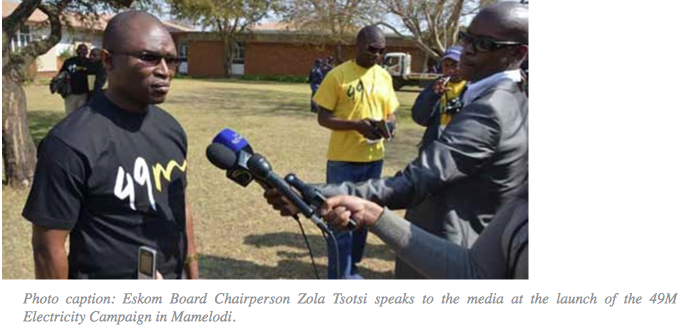
Spring is in the air and you can do with less electricity than you used during the cold winter days.
This is the message from Eskom and the Public Enterprise Department as they embark on a campaign to get 49 million South Africans to save electricity. The campaign, which aims to reduce electricity consumption by 10 per cent, got underway in Mamelodi township, east of Pretoria recently.
Eskom Board Chairperson Zola Tsotsi said South Africa could not afford to go back to the energy load-shedding that affected the country in 2008.
“The risk of load-shedding is very low, in fact I have said load-shedding is not in my vocabulary but if we don’t save energy as we should anything is possible and we don’t want to go there,” Tsotsi said.
He was speaking after a 49M electricity saving campaign roadshow in Mamelodi, east of Pretoria. The 49M campaign is conducted by Eskom and the Department of Public Enterprise.
Eskom is now using the 49 M campaign to shift the focus to consumers, particularly households.
The 49 M campaign seeks to encourage 49 million South Africans to save electricity and officials are using celebrities in visits to all of the country’s nine provinces to drive the message home.
South Africans are encouraged to start thinking about their power consumption and reminding one another to ‘remember their power’.
Public Enterprise Deputy Minister Bulelani Magwanishe told a large crowd of Mamelodi residents that by saving electricity they were not doing government a favour.
“In fact by saving you are helping yourselves because it means more money in your pocket,” Magwanishe said. He warned that rising electricity costs were leading to job losses and increases poverty. Electricity wastage was also putting severe pressure on the national grid.
“We don’t want to go to a situation that we saw in 2008 so let us save as much as we can,” he said in reference to the rolling black outs of that year.
Deadly illegal connections
The Deputy Minister also called for a renewed fight against illegal connections which are notorious in townships like Mamelodi.
Authorities say illegal connections cost the country R4,4 billion per annum.
“It’s a very serious problem because it also involves loss of life…also these illegal connections are stealing from communities and the South African society as a whole, so it’s a very serious matter,”
In the meantime, play your part and keep your electricity usage to a minimum.
For more information, call the Department of Public Enterprises: 012 431 1000
Taking hold of their destiny against all odds
Taking hold of their destiny against all odds sadminYouth matters
Taking hold of their destiny against all odds
Samona Murugan
Young South Africans who have made a success of their lives, and who continue to make a meaningful change in their communities and the country were honoured at the South African Youth Awards last month. The event themed “Against all odds” was hosted by the National Youth Development Agency (NYDA) to recognise outstanding achievements by youth between 14 and 35 years. Being the first event of its kind in the country, NYDA CEO Steven Ngubeni said the awards, was both inspiring and spectacular. “We want to give hope back to young people who have lost hope for a better life due to rising unemployment… we want young South Africans to learn from the strength, determination, commitment and courage of these ordinary South Africans and resolve to do it for themselves and their country.”
Ngubeni had a simple message for the youth of South Africa; “Your circumstances do not define your future. Limitless youth, rise up and take hold of your destiny.”
An amazing 1 018 nominations were received for the awards, which coincided with Youth Month in June. The red-carpet event, which took guests down the country’s history with songs from prominent South African musicians, saw inspiring stories of youth from different backgrounds soaring despite the odds.
There were nine award categories, including academic excellence, arts and entertainment, entrepreneurship, extraordinary champions, health and wellbeing, science and technology, social cohesion, environment and the Presidential Award.
Winners in each category received R50 000 and runners up R20 000. As the overall winner Nolwazi Pinkie Madlala walked away with an additional R100 000 and a bursary.
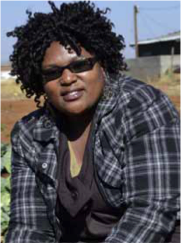
Environment/Agriculture: Ntombomzi Tsotetsi
Ntombomzi Tsotetsi was honoured for her contribution to the environment. She is a farmer and hosts workshops in her community to teach people about the environment, climate change and how to grow organic vegetables. She has established a number of food gardens in schools and has created 100 jobs in the Vaal area. Tsotetsi loves being part of something that gives back to the community. A firm believer in developing skills and knowledge and helping young people build a brighter future, she hopes to train more people in environmental issues especially young women.
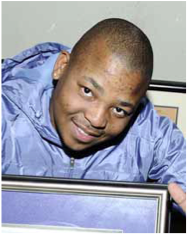
Science and technology: Sir Stuart Ntlathi
Sir Stuart Ntlathi, who invented a 15-in-1 microwave oven, an electronic Vuvuzela and an auto shoe polisher, says the SA Youth Award is his 45th science and technology award. This 25-year-old, who will be joining Sir Branson in the Virgin Galactic space trip, has been rallying youngsters to get them excited about science and technology since he was 13 years old. Being in the industry hasn’t been an easy ride for Ntlathi, as he experienced resistance from within his own community to his passion for science. But hard work and dedication saw him rising above the odds. In his acceptance speech Ntlathi reminded guests that education was the key to success. “Geniuses themselves don’t talk about the gift of genius - but only about hard work and long hours.”
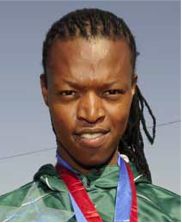
Arts and entertainment: Paul Modjadji
Born in Hammanskraal near Pretoria, Modjadji believes that he is an agent of change through his dancing, which has seen him receive standing ovations on world stages, including Denmark and New York. Despite growing up in a town where there was not a single formal dance studio, Modjadji received the Global Youth Leadership Award from the Global Youth Leadership Congress in Washington DC for his contribution to the Dance community.
Paul learned to dance from watching TV dance shows and he caught the attention of the Dance Academy in Denmark earning him a yearlong scholarship. Since returning he has represented South Africa on four international platforms, and received an award from the 2011 European Star Dance Championships held in Croatia for his solo performance in Jazz. Despite lack of sponsorship he runs the Dare to Dream workshops and the Arts in Motion Academy where he teaches music, dance and drama.
However, he says funding was a big challenge because “people still think dancing is just a hobby. But like other professions, dancing needs money and support.” His message for the youth is to pursue their dreams with whatever they have. “Fight for excellence
- like the youth of 1976, who fought for a unifying cause – freedom.”
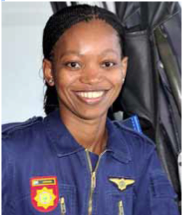
Entrepreneurship: Refilwe Ledwaba
Refilwe Ledwaba, who has established the South African Women in Aviation and Aerospace Industry (SAWIA), a non-profit organisation aimed at empowering women in aviation, was awarded for entrepreneurship. Despite many challenges in a career that has traditionally been dominated by men, Ledwaba’s love for aviation has always been her inspiration. She received her commercial helicopter pilot licence in 2005, becoming the first black woman pilot in the South African Police Service. Encouraging other young women to follow their dreams, she said, “I’m really happy that others may also follow this exciting career.”
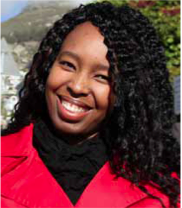
Extraordinary champions: Nolwazi Pinkie Madlala
Durban born Nolwazi Pinkie Madlala, who received the Extraordinary Champion Award, as well as the Presidential Award, stole the show. Madlala, who lives with a disability, has overcome adversity and is currently working towards a Master of Arts degree in Clinical Psychology. According to the NYDA, Madlala is an inspiration to others “to soar beyond the sky.”
She grew up in Mphophomeni near Howick in KwaZulu-Natal where she not only lost both her parents at the age of 12, but also survived a car accident that killed her sibling and left her with a disability. Despite her disability, Madlala went on to study for a Bachelor of Arts degree in Social Science. She is currently an intern clinical psychologist at 1 Military Hospital in Thaba Tshwane.
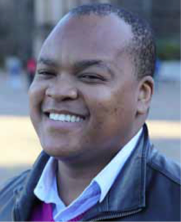
Academic excellence: Peter Malati
Peter Malati from Seabe Village in Mpumalanga is a post-doctoral candidate in Chemical Engineering at the University of Cape Town. He runs a Chemistry project in six high schools in Nokaneng Circuit in Mpumalanga, mentoring rural learners in Science and Engineering. Growing up and going to school in a rural area, Peter understands the challenges rural learners face. He managed to beat the odds to reach great heights and is now using his own experiences to inspire rural youth to excel in Science and Maths.
In 2011, the Brightest Young Minds organisation selected him to attend their annual summit as one of South Africa’s brightest young minds representing the brilliance and diversity of our country. Hundred delegates are selected each year on the criteria of innovation, leadership and academic accomplishments.
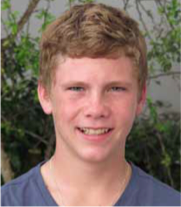
Health and wellbeing: Ross Mcreath
Ross McReath received this award for running a cricket club for the youth of Nolukhanyo Township in the Eastern Cape. The club gives these youngsters an opportunity to develop their talents and provides access to professional trials. Since many of them are from disadvantaged backgrounds, it also gives them a chance to experience life beyond township boundaries.
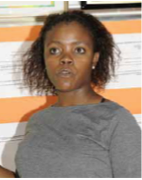
Social cohesion: Lebogang Bogopane
This award went to Lebogang Bogopane who was born North West. Lebogang makes a difference in the lives of many people as a volunteer at a 24-hour centre for abused and abandoned children and women. She not only counsels the victims, but cooks for them, feeds them and helps to bathe them. When necessary, she also refers them to relevant professionals for further assistance.
For more information, call the NY DA : Tel 08600 96884; Fax 086 766 3492
The South African Medical Association bursaries: Important information
The South African Medical Association bursaries: Important information sadmin
Dear Medical Student
The South African Medical Association Medical Student Bursary is to the value of R20 000 per annum from the first to the fourth year of studies and will be offered to a deserving student who is already studying towards a MBChB or equivalent degree, but finds that due to financial pressures that he/ she is unable to continue his/ her studies.
VERY IMPORTANT
• Only applications in respect of the study in the medical field i.e. MBChB or equivalent degree at a South African university will be considered.
• Application forms may be downloaded from our website via www.samedical.org -> About us -> Bursaries & Scholarships.
• While financial need is an important consideration, applications are evaluated in the first instance on academic merit.
Only students with an above average aggregate need therefore apply.
• Answer all questions in full, and make sure that two recent reports and a testimonial are enclosed with your application.
Applicants are also expected to furnish a copy of their mid-year exam results before the closing date.
• Finalists may be requested to submit certified proof of financial circumstances before bursaries are awarded.
• The decision of the Bursaries Committee is final and no correspondence will be entered into with regard to unsuccessful applications.
• Due to the large number of applications received it will not be possible to acknowledge receipt of applications, or to advise all applicants of the outcome. For that reason only successful candidates will be advised. Applicants who have not received notification by 30 December may assume that their applications have been unsuccessful.
The South African Medical Association bursary is to the value of R20 000 per annum and is intended to assist needy medical students who have outstanding scholastic records, during their preclinical study years.
VERY IMPORTANT
• Only applications in respect of first year medical studies (MB ChB or MB BCh) at a South African university will be considered.
• Application forms may be downloaded from our website via www.samedical.org -> About us -> Bursaries & Scholarships.
• While financial need is an important consideration, applications are evaluated in the first instance on academic merit. Only students with an A aggregate need therefore apply.
• Answer all questions in full, and make sure that two recent reports and a testimonial are enclosed with your application. Applicants are also expected to furnish a copy of their mid-year exam results before the closing date.
• Finalists may be requested to submit certified proof of financial circumstances before bursaries are awarded.
• The decision of the Bursaries Selection Committee is final and no correspondence will be entered into with regard to unsuccessful applications.
• Due to the large number of applications received it will not be possible to acknowledge receipt of applications, or to advise all applicants of the outcome. For that reason only successful candidates will be advised. Applicants who have not received notification by 30 December may assume that their applications have been unsuccessful.
Closing date for receipt of applications is 30 September. Applications received after this date will not be considered under any circumstances.
Post applications to: The Bursaries Officer, South Africa Medical Association,
P O Box 74789, Lynnwood Ridge 0040.
Attention: Mrs KARLIEN PIENAAR
BURSARIES OFFICER
US to help strengthen education
US to help strengthen education sadminInternational relations
US to help strengthen education
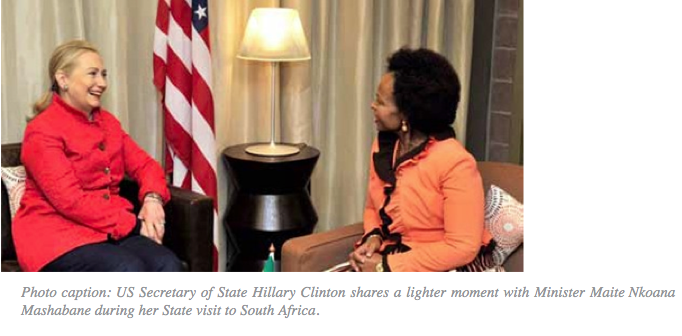
South African and the United States have pledged to strengthen their relationship following a recent visit by the US Secretary of State Hillary
Clinton.
One of the major announcements made by Clinton during a meeting with South Africa’s Minister of International Relations and Cooperation Minister Maite Nkoana Mashabane was a commitment of $500 000 to help South African students to study in the United States. “We recognise that strengthening South Africa’s education, like in any country, is essential to your economic future,” she said. The two countries also agreed to build closer cooperation in areas of aviation, energy and security. Maite Nkoana Mashabane told Clinton that South Africa stood ready to welcome any partner that would further promote the country’s growth objectives.
The two ministers further promised to continue their partnership in fighting HIV and AIDS. Clinton said the US was “still seriously committed” to eradicating HIV and AIDS and would continue to avail resources in this regard.
“We all agree that we are working towards this HIV-free generation and America commits to be part of that fight. We will see this fight through to the end with our partners, including South Africa.”
Nkoana Mashabane also used the opportunity to invite the US private sector to invest in South Africa’s infrastructure development programme announced by President Jacob Zuma earlier this year.
Vuk’uzenzele: some facts and figures
Vuk’uzenzele: some facts and figures sadminVuk’uzenzele 50th Edition Special
Vuk’uzenzele: some facts and figures
• Vuk’uzenzele started in October 2005 with a print run of 1 million copies every second month.
• Its print run is currently 1,7 million copies every month.
• More than 72 million copies have been produced and distributed to date.
• It is the only newspaper in South Africa that is published in all the official languages and in Braille.
• Almost 19 000 Bra have been
• It has the largest circulation of any newspaper in S and is distributed to rural areas in all nine provinces.
Wuduza farm workers grow into farmers
Wuduza farm workers grow into farmers sadminRural development
Wuduza farm workers grow into farmers
Tabita Ngqunge & Thomas Thale
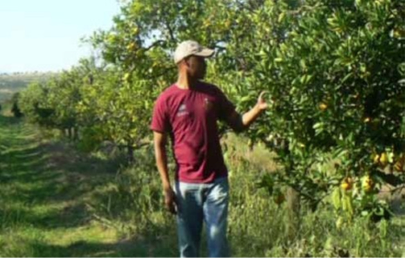
Photo caption: Wuduza farm produces high-quality oranges mainly for the export market.
When the Ulimocor Parastatal of the former Ciskei government was liquidated in 1997, the future looked bleak for the Battlesden Farm and its employees.
But the Department of Agriculture, the then Department of Rural Development and Agrarian Reform and the Industrial Development Corporation (IDC) came to the rescue. They helped with transfer of the land to former employees, enabling them to resuscitate the orange orchards.
Overnight, the small group who were working the orchards had security of tenure on the land situated in the Amathole district of the Eastern Cape. They set to work ¬– only this time, it was for their own direct benefit.
The landscape changed from overgrown stretches of grass to a shiny green and yellow, as trees began yielding high-quality oranges, mainly for the export market.
The 25 hectare piece of land was identified
and a long lease was concluded with the Community Property Association (CPA). The farm was now theirs to develop as a business, which became known as Wuduza.
Farming revival
One of the beneficiaries, Bonakele Katyana from KwasiKhutshwana village in the Eastern Cape, recalls how it all started. “The eight of us applied to the Department of Land Affairs for the land. We then agreed to pool our pension payout from the farm to buy diesel and fertilisers to keep the farm going.”
The Amathole District Municipality bought a tractor, built a shed and fenced the fields for the budding farmers. In 2006, the Riverside Advisory Services came on board, offering technical, administrative, financial and mentorship support.
Colin Painter, Managing Director of River- side, says Wuduza is one of 19 farms they look after. “The Industrial Development Corporation (IDC) wanted to revive farming in the whole of the Amathole District. Wuduza is one of the first nine farms helped by Riverside to get funding from the IDC.
“The Department of Agriculture, under the Comprehensive Agricultural Support Programme (CASP), also assisted many of the other farmers from 2006 with R8,5 million in development finance. The department funded a further R1 million towards a one hectare intensive blueberry development under shade cloth. We have our own farms, agri-processing and fruit-handling facilities as well, so we have the right expertise.
Wuduza received a loan of R1,25 million from the IDC. Riverside keeps an eye on things to ensure that the farms develop and that farmers service their debt to the IDC and reinvest in the business for export. This money was used to establish orchards and for working capital. By 2010, the farm was yielding enough high-grade oranges for markets in the United Kingdom, Europe, the Far East, Canada and Russia.
Mzo Msimang, Project Coordinator for the Amathole District in the Department of Rural Development and Land Reform, describes Riverside as a strategic partner.
“Through our new Recapitalisation and Development Programme (RECAP), farmers are able to access infrastructure development funding. However, there are strict controls in place. The programme is audited by PriceWaterhouseCoopers and is mentor-controlled.”
RECAP also funds mentorship and training programmes. Msimang says the programme aims to help small-scale farmers graduate into commercial farmers under the supervision of experienced mentors.
RECAP provides emerging farmers with agricultural infrastructure such as plants, irrigation equipment, fencing and plant material, as well as other resources, including fertilizers and chemicals
This year, Riverside helped Wuduza to get approval for R3,5 million from the provincial Department of Agriculture.
Creating jobs
With agriculture being at the mercy of weather conditions, the farm is still recovering from a devastating hailstorm in 2011, which damaged the yield. However, Painter is confident that the farm will be able to export again in the 2013 season.
“The farm should be able to produce high- quality oranges for the export market next year. The orchard planting will be completed in spring this year and the business will be in full production with citrus, berries and pomegranates in four to five years’ time.”
Wuduza also creates jobs for the community.
It currently has eight casual and three permanent workers and employed 28 casual workers last year. Wuduza members have also changed from being employees to being employers on the farm.
“Our government has done a lot for us; this project has given birth to another community project on this same title deed, which is benefiting the community and is wholly owned by the community,” says Katyana.
Zambian doctors impressed by SA’s TB facilities
Zambian doctors impressed by SA’s TB facilities sadminZambian doctors impressed by SA’s TB facilities
Howard Kgoa - Department of Health
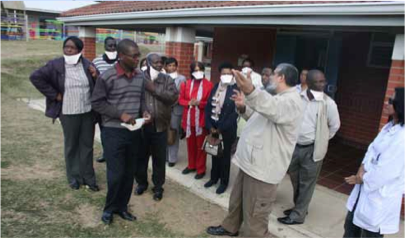
Photo caption: A delegation of Zambian doctors with hospital staff during a visit to the King George V Hospital in Durban.
A delegation of Zambian doctors on an educational tour to South Africa has lauded the country’s multi-drug resistant (MDR) TB sites.
The four doctors visited MDR units at Tshepong Hospital in Klerksdorp, North West and at the King George V Hospital in Durban. Their visit follows a similar visit by Chinese doctors in April this year.
These visits indicate that South Africa’s healthcare expertise and technological advance is gradually positioning itself as a centre of excellence and the international community is taking note.
Dr Charles Kayuunga, who led the Zambian delegation, said the purpose of their visit was to learn more about the management of drug- resistant TB by observing the management practices at the sites, especially at the National Health Laboratory Services unit in Klerksdorp.
He noted that they were impressed by the professionalism of the staff at the unit. “Nurses at the hospital showed excellent interpersonal skills, which is important for their patients’ quick recovery”.
At the King George V Hospital the delegation observed the renovations that were in progress to improve the quality of patient care in line with world standards. Among the facilities that impressed the delegation was a primary school on the premises which helps children who are infected with MDR TB keep up with their school- work during long periods of hospitalisation.
David Mametja, Cluster Manager TB Control and Management at the Department of Health, said the department appreciated hosting other countries and felt privileged that Zambia had chosen South Africa to learn best practices in health matters.
There are 33 MDR TB sites throughout the country, with some being upgraded and expanded. New wards at an MDR TB complex at Sizwe Tropical Disease Hospital in Gauteng will increase the hospital’s capacity from 266 beds to 312 and introduce single-cubicle beds to prevent the spread of TB infections.
In 2010, the national TB cure rate reached the 70 per cent mark for the first time.
For more information about TB, call the Department of Health on: 012 395 8086/8080, or visit www.doh.gov.za